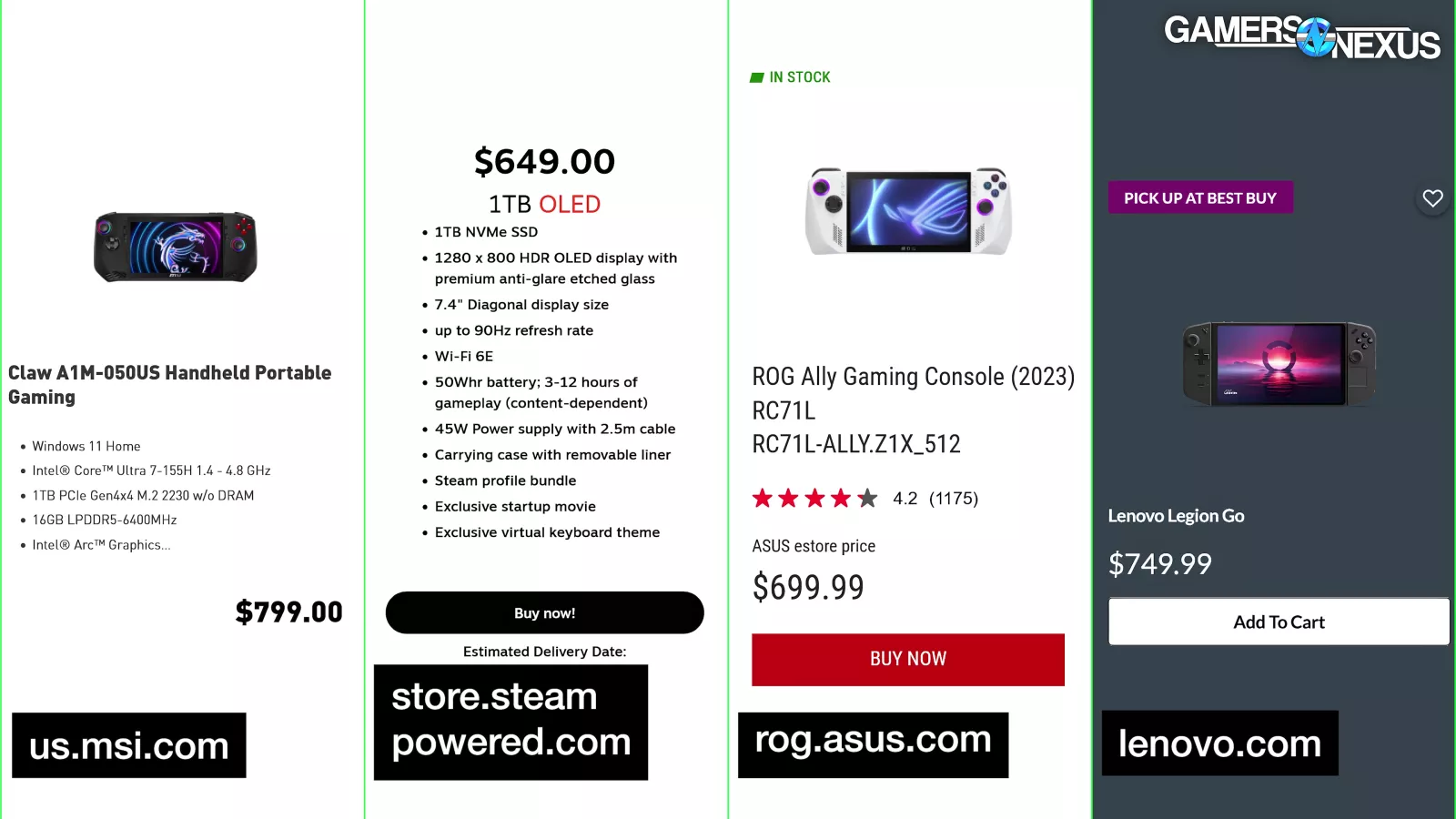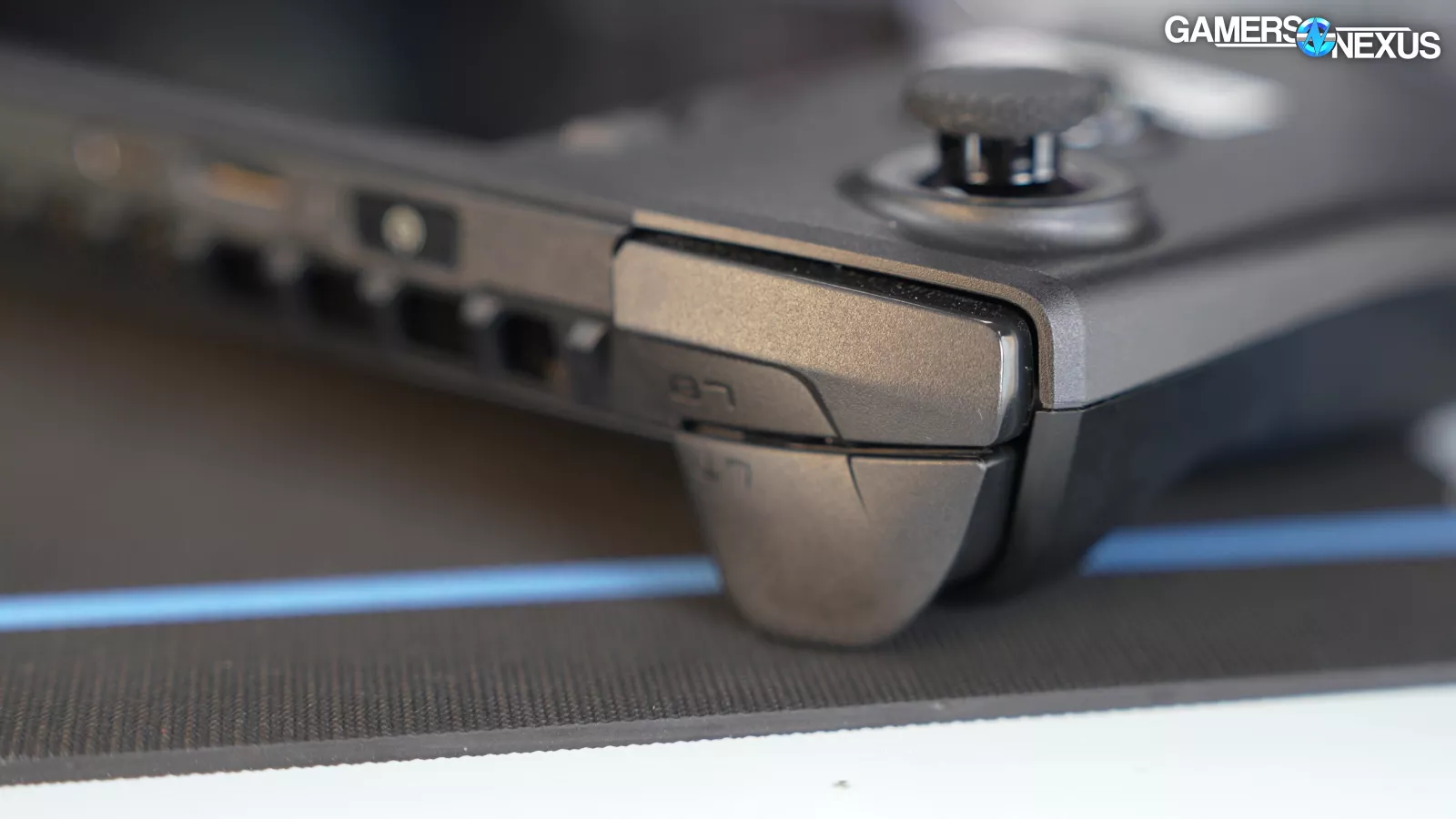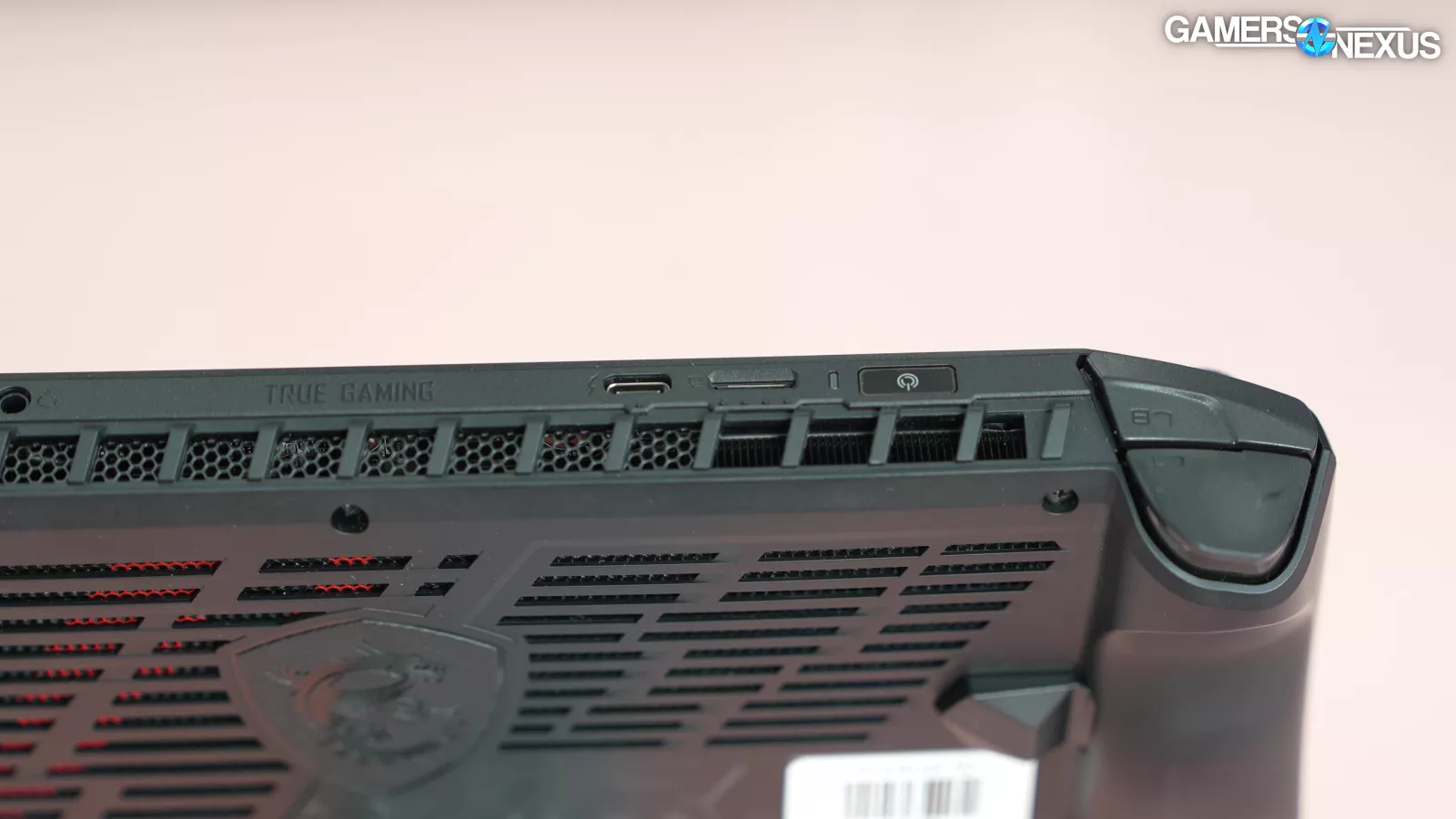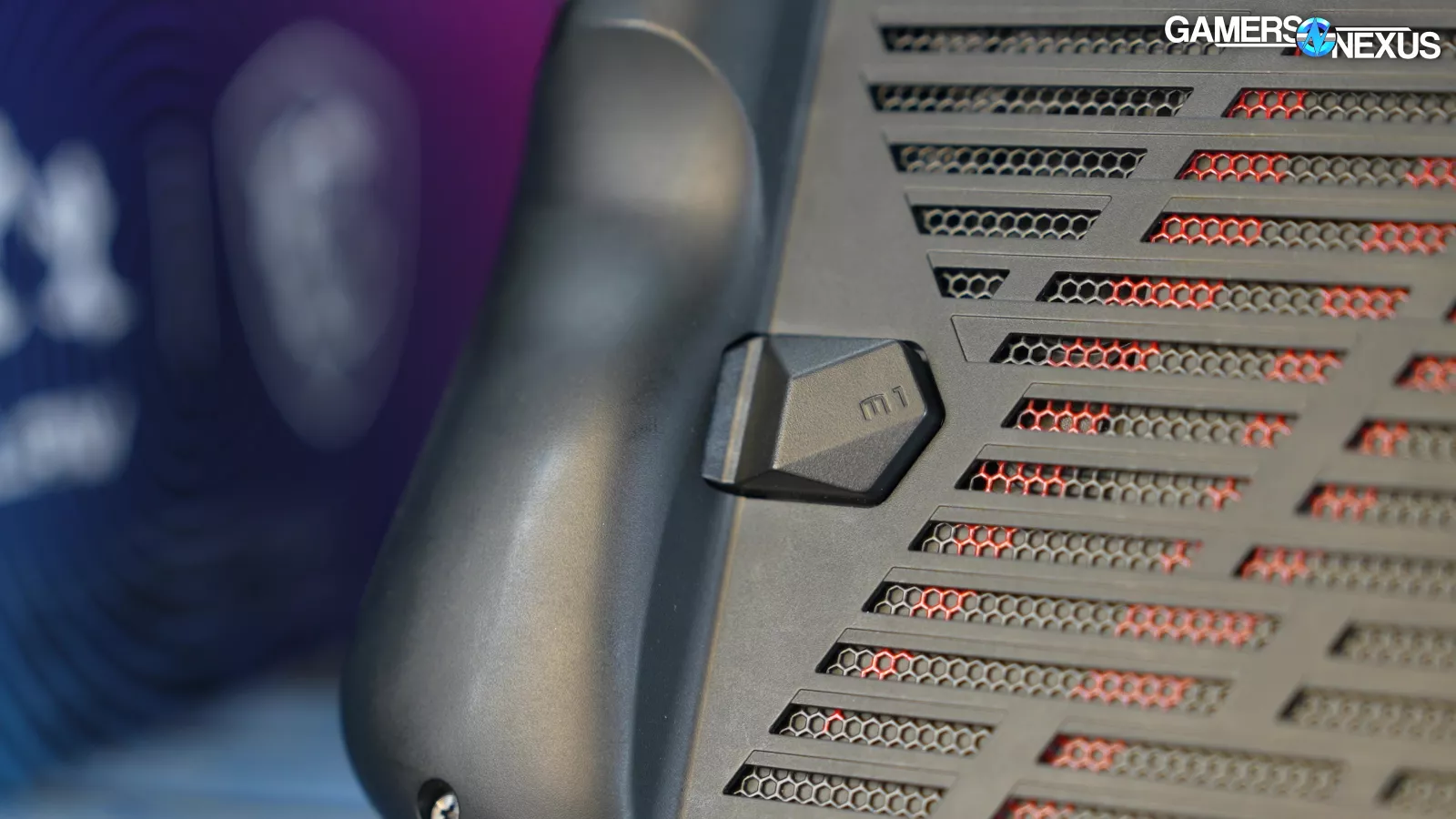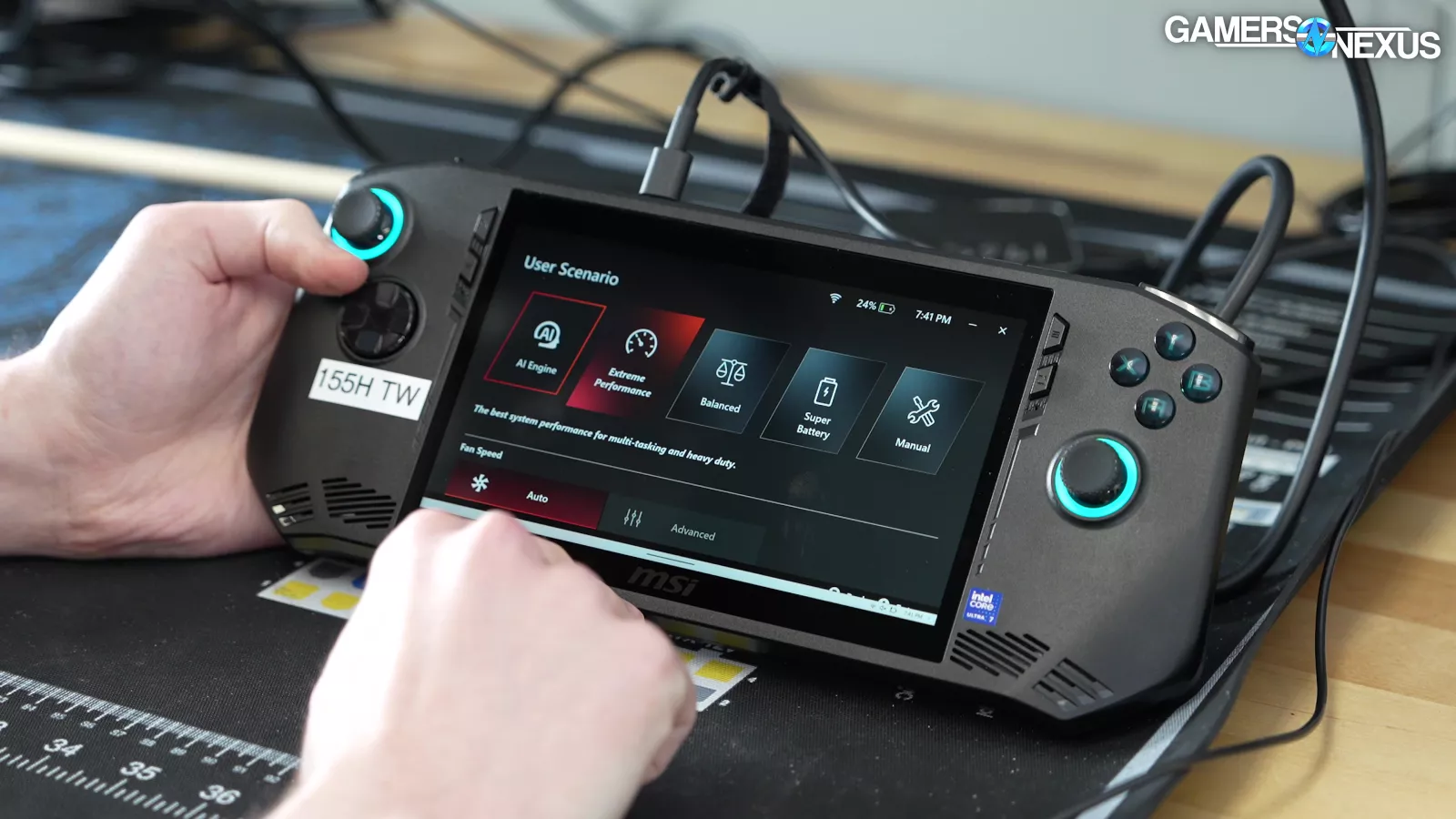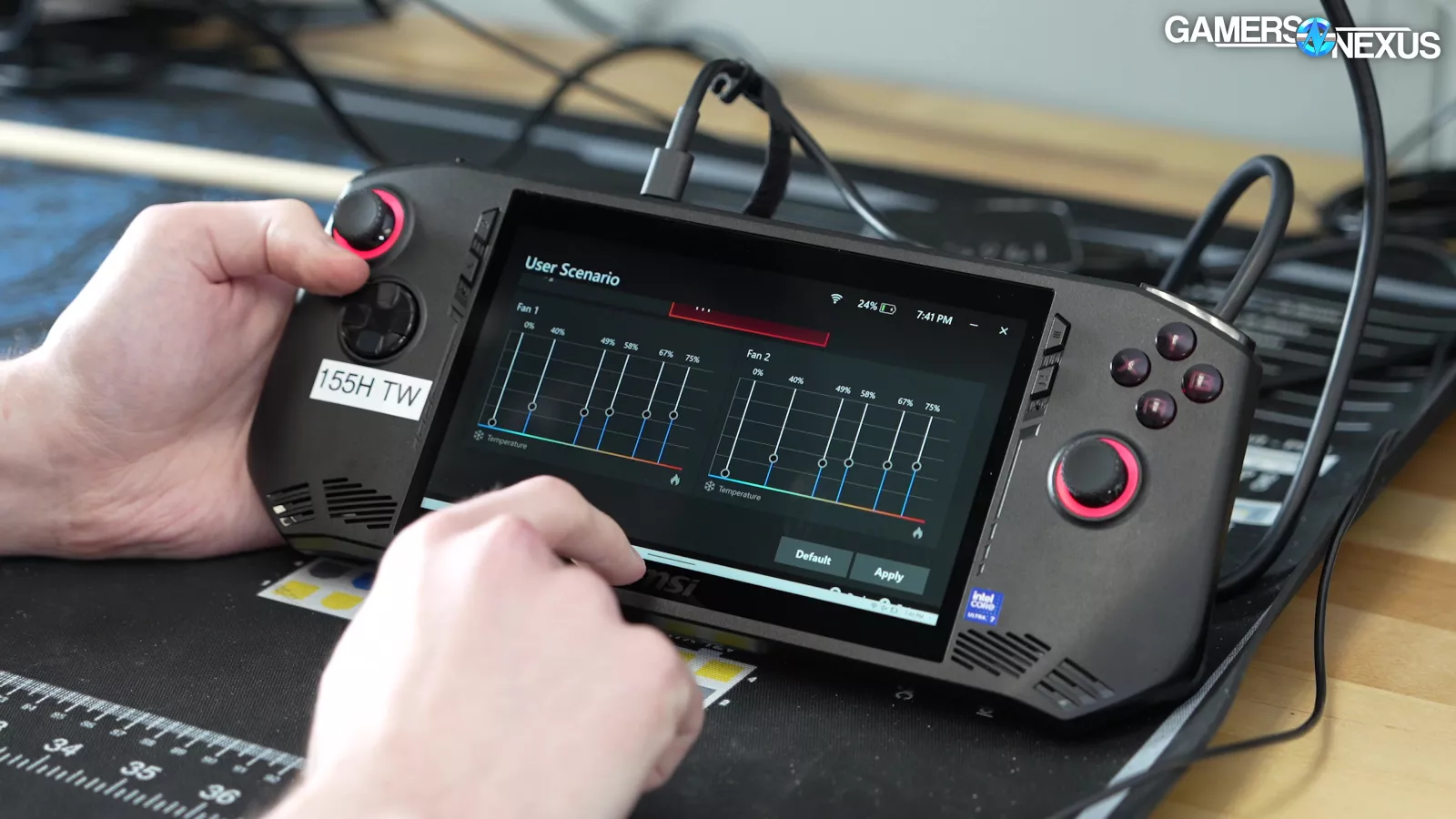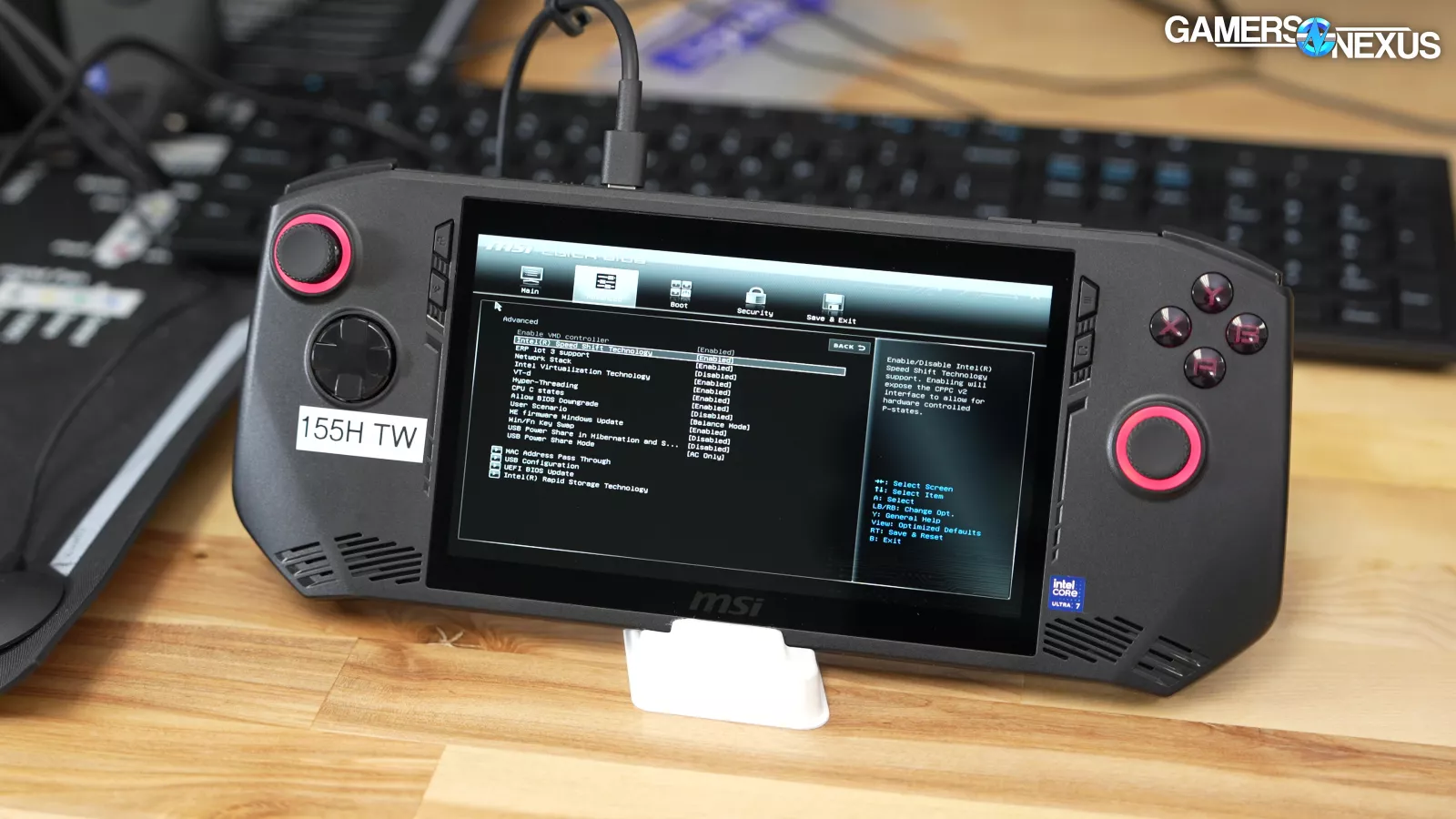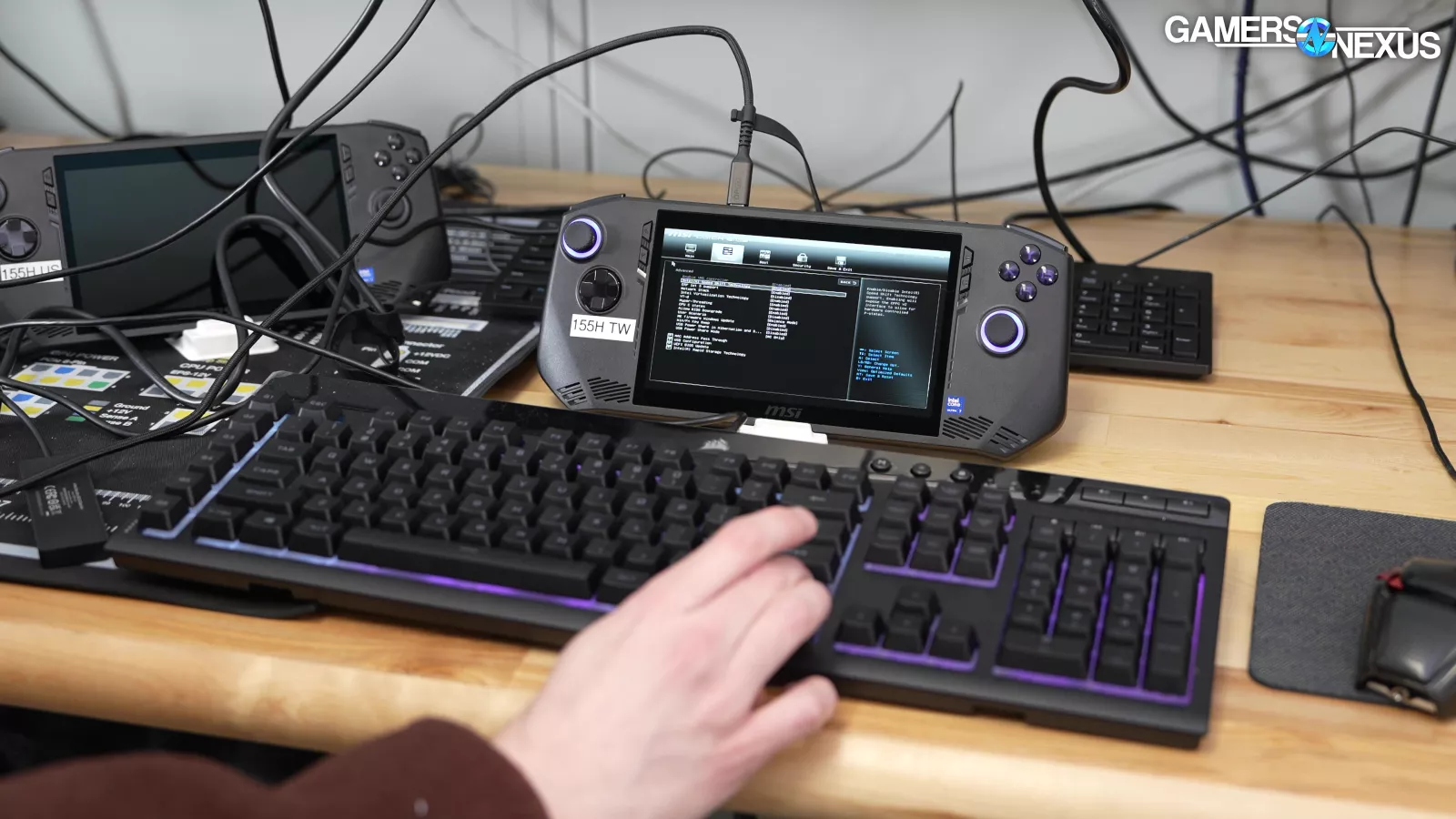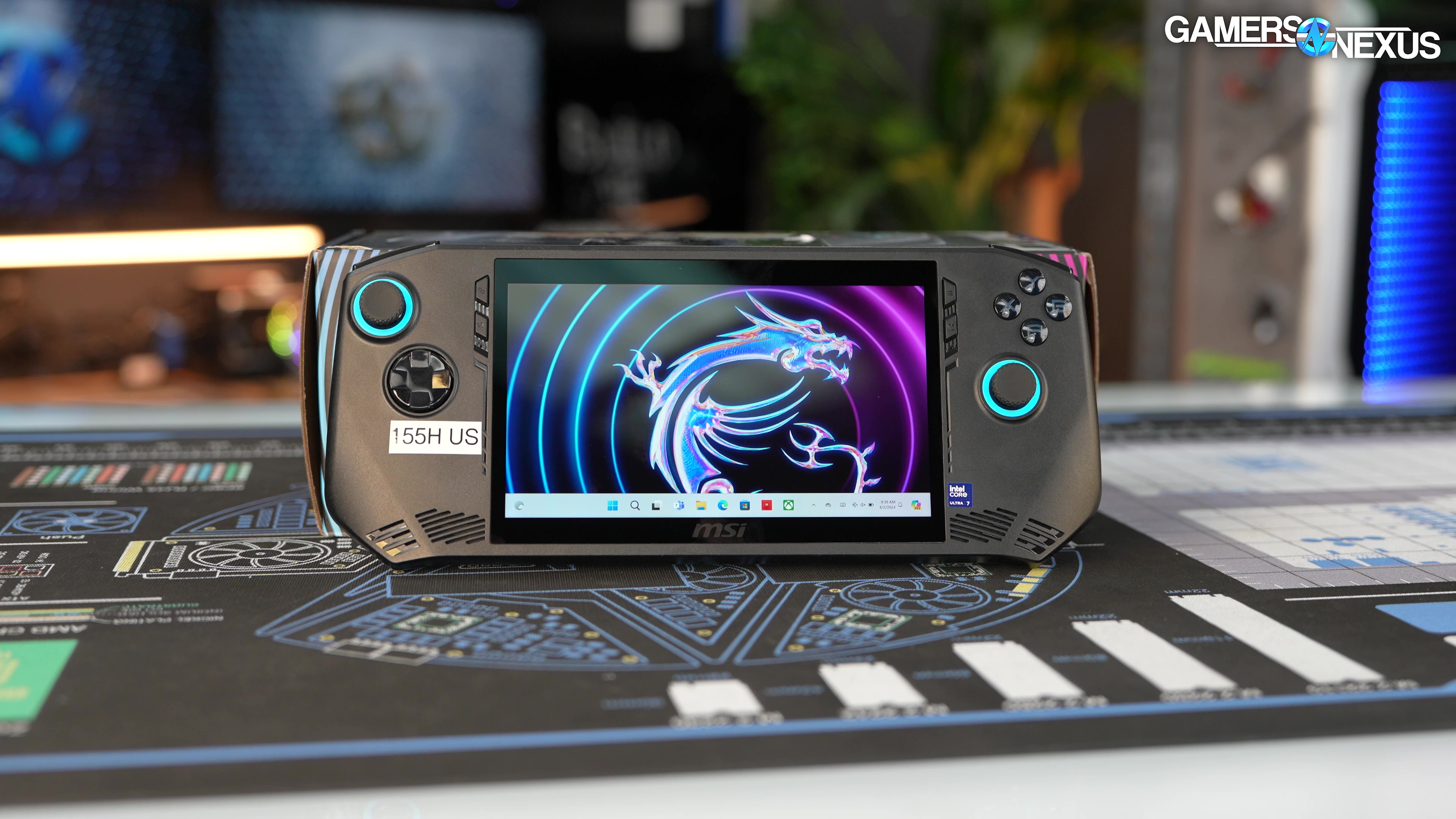
The MSI Claw is a Mess: Gaming Handheld Can't Compete | Review & Benchmarks
Last Updated:
We review the MSI Claw's hardware, software, battery life, charging, thermals, and gaming performance
The Highlights
- Unlike most other PC handhelds, the MSI Claw eschews AMD in favor on an Intel CPU
- The MSI Claw sometimes had remarkably bad frametime pacing
- Overall, there are cheaper and better gaming handheld alternatives
- Original MSRP: $700 - $800
- Release Date: March 8, 2024 (In the US)
Table of Contents
- AutoTOC
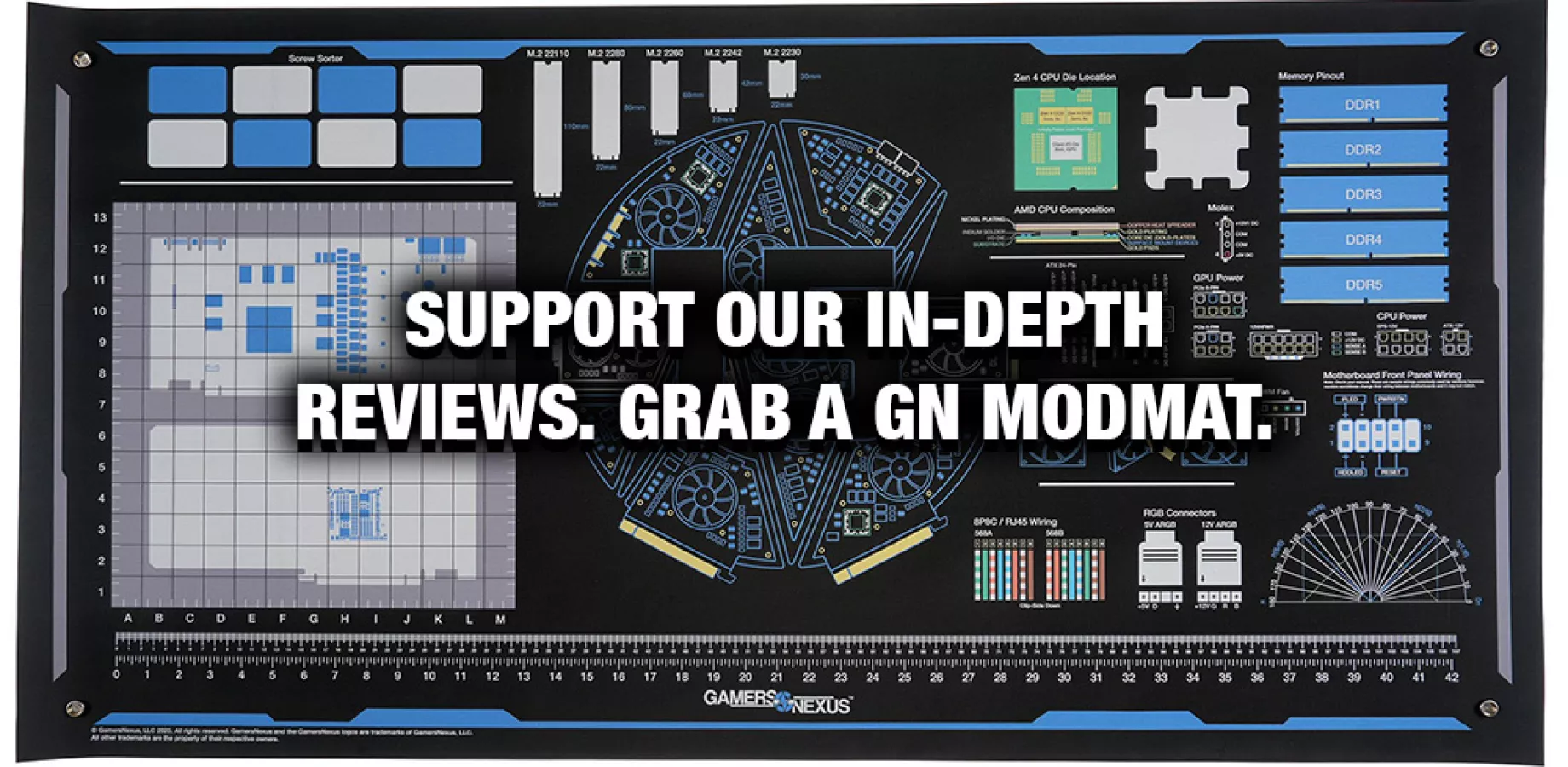
Intro
MSI initially didn’t want to send us a Claw review sample, but it had already launched in non-US parts of the world and they told us that it’d be months before they could send us one. We’re always skeptical of this, especially given our past with MSI where the company often deploys a strategy of delaying, and since we were flying to Taiwan anyway, we decided to reply to MSI and let them know that it’s no problem, we’d be buying one from a mall. It cost us $800, and it was immediately apparent that stock was plentiful, but that the Claw had a problem. No one was buying it. The store clerk told us, “I’ve heard of it, I’ve seen it, no one has ever bought it. You are the first one.” And this is coming from the biggest tech mall in Taipei. The clerk told us they’d had it for a month already at that point. When we asked what everyone else was buying, he said the ASUS Ally.
That’s not a good sign for MSI.
Editor's note: This was originally published on April 14, 2024 as a video. This content has been adapted to written format for this article and is unchanged from the original publication.
Credits
Testing, Host, Writing
Steve Burke
Testing, Writing
Patrick Lathan
Camera
Vitalii Makhnovets
Video Editing, Camera
Tim Phetdara
Web Editing
Jimmy Thang
After we told MSI we’d be buying one, they said they’d send us one after all. Oddly, the unit they sent had been tampered with despite saying it’d represent retail: It had a Windows account already created, it had games installed, it had 3D Mark traces left behind, and had clearly been used. We never trust a device with an operating system when it’s been tampered with, mostly because it’s hard to know if they’ve changed any of the power behaviors. We can’t know that it hasn’t been “improved” or cherry-picked, so we shelved it and used the one we bought instead.

Our first impression was that we didn’t like the squishy bumper button. And our second impression was the device sounding like it was dying, except actually it was the built-in vibration feature. You can listen to it here.
But some basics first: The Claw A1M is an ill-fated, new Intel-powered handheld from MSI.
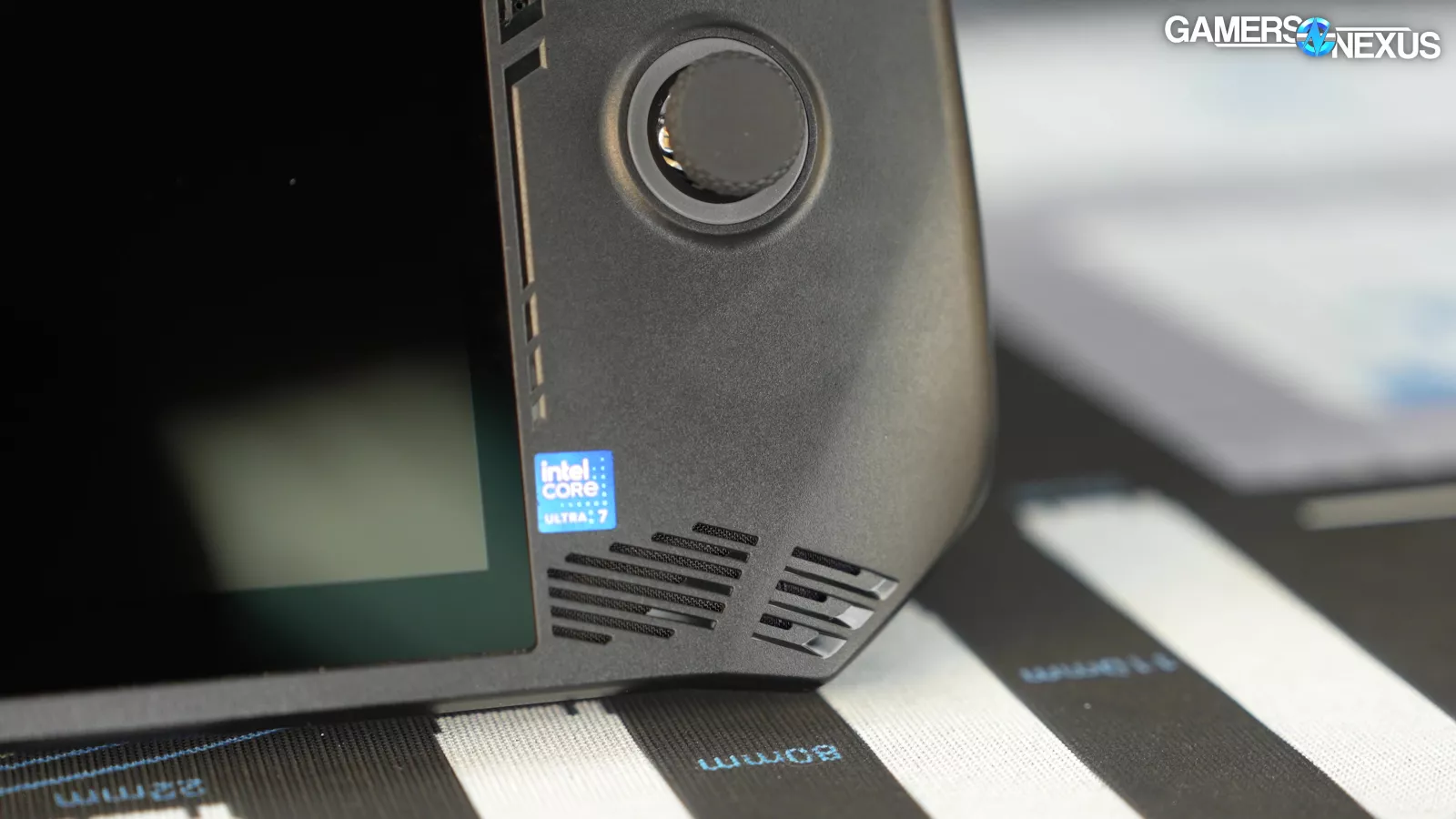
The Intel part is unique among mainstream handhelds: almost all of them use AMD. Smaller companies like GPD and ONEXPLAYER have sold Intel handhelds, but Claw is a radical exception for one of the hardware giants.
MSI is selling three variants: an Ultra 7-155H model with a 1TB drive for $800, the same but 512GB for $750, and an Ultra 5-135H model with a 512GB drive for $700. The $800 model is more expensive than the top-tier offerings from Valve at $650, ASUS at $700, and Lenovo at $750 plus or minus the regular sale prices. MSI is entering the competition against powerful opponents that are already slashing prices on first-gen models and open-box units.
The Claw's performance needs to be indisputably strong. Given our mixed coverage of Arc, we have doubts.
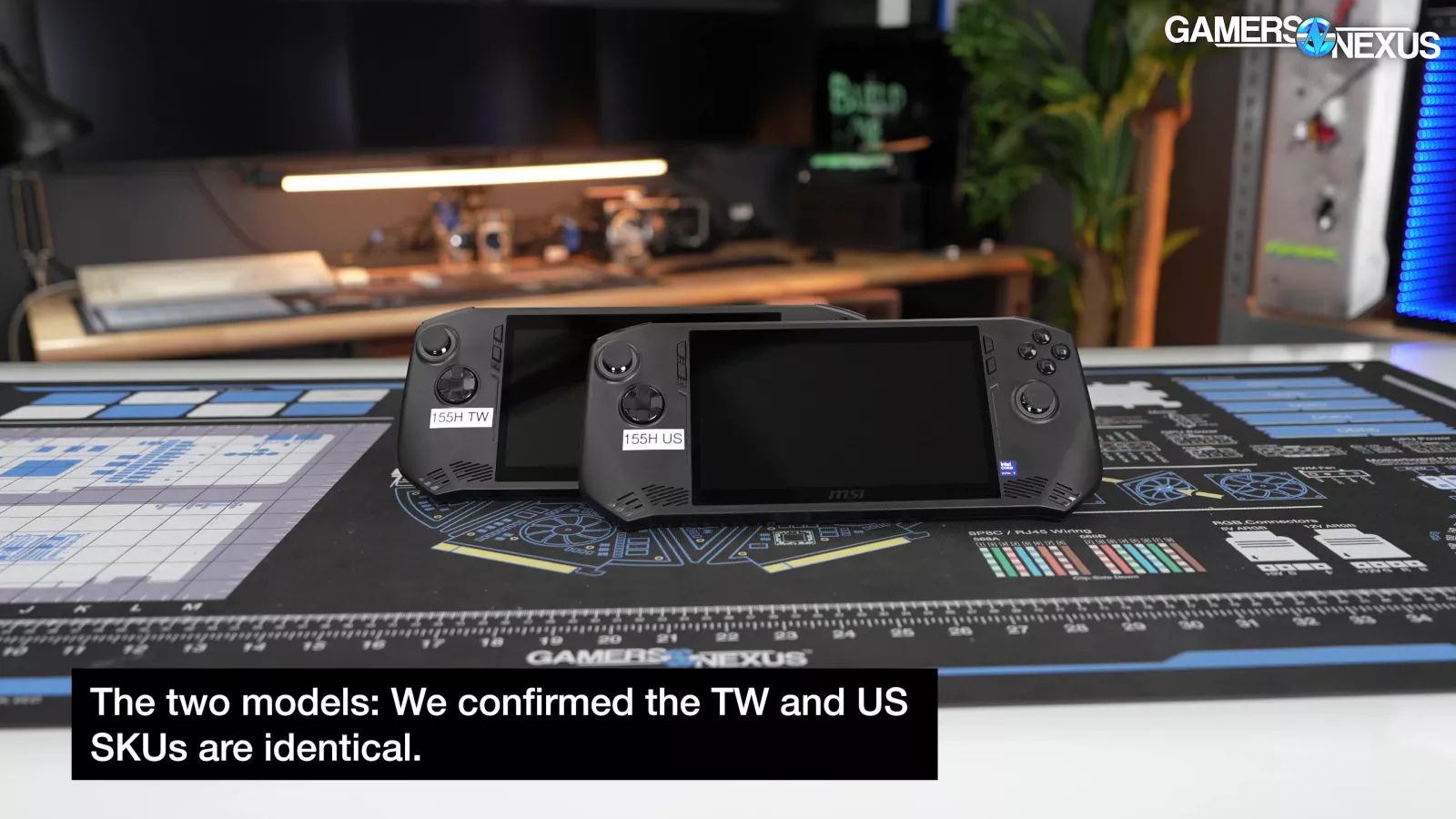
The Claw that we're using for this review is an A1M-026TW, technically the Taiwanese variant of the top spec, but we’ve confirmed it's identical to the US SKU.
Let’s address the obvious part first:
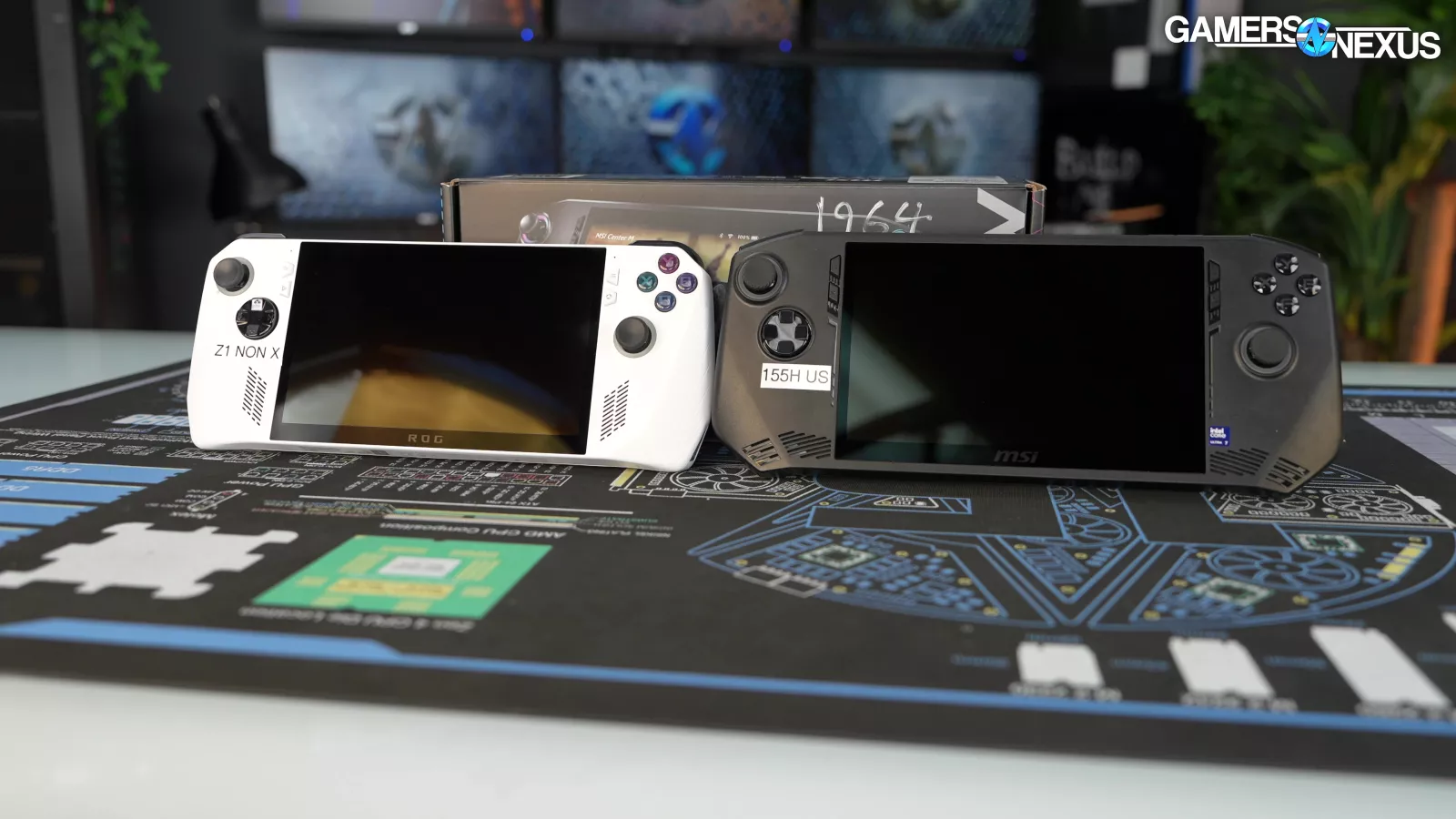
It looks like an Ally. In fact, the first thing that Tim, one of our camera operators, and Patrick, who wrote most of this review, said was that it’s almost identical.
We had spoken with MSI about the Claw in Taiwan and the team told us that they began design immediately after the Deck launched. They claimed the inspiration was the Xbox controller, as their research indicated it was the most popular on the market. Fair enough. But it still looks exactly like an Ally (watch our review here), whether or not that was factored into the process.
There are small differences: the Ally's grips flow into the back more gradually, and the shape and positioning of the Claw's rear buttons isn't as good. These are subtle though, and, for the most part, the Claw handles exactly the same as an Ally except with a disgustingly squishy bumper button that just sinks on press. It’d be like if you damped your keyboard switch with jello. For our money, the cushy grips on the Deck and Legion Go are more comfortable than either, despite "Ergo-Gaming Science of Comfort" achieving "Perfection Through Anthropometry."
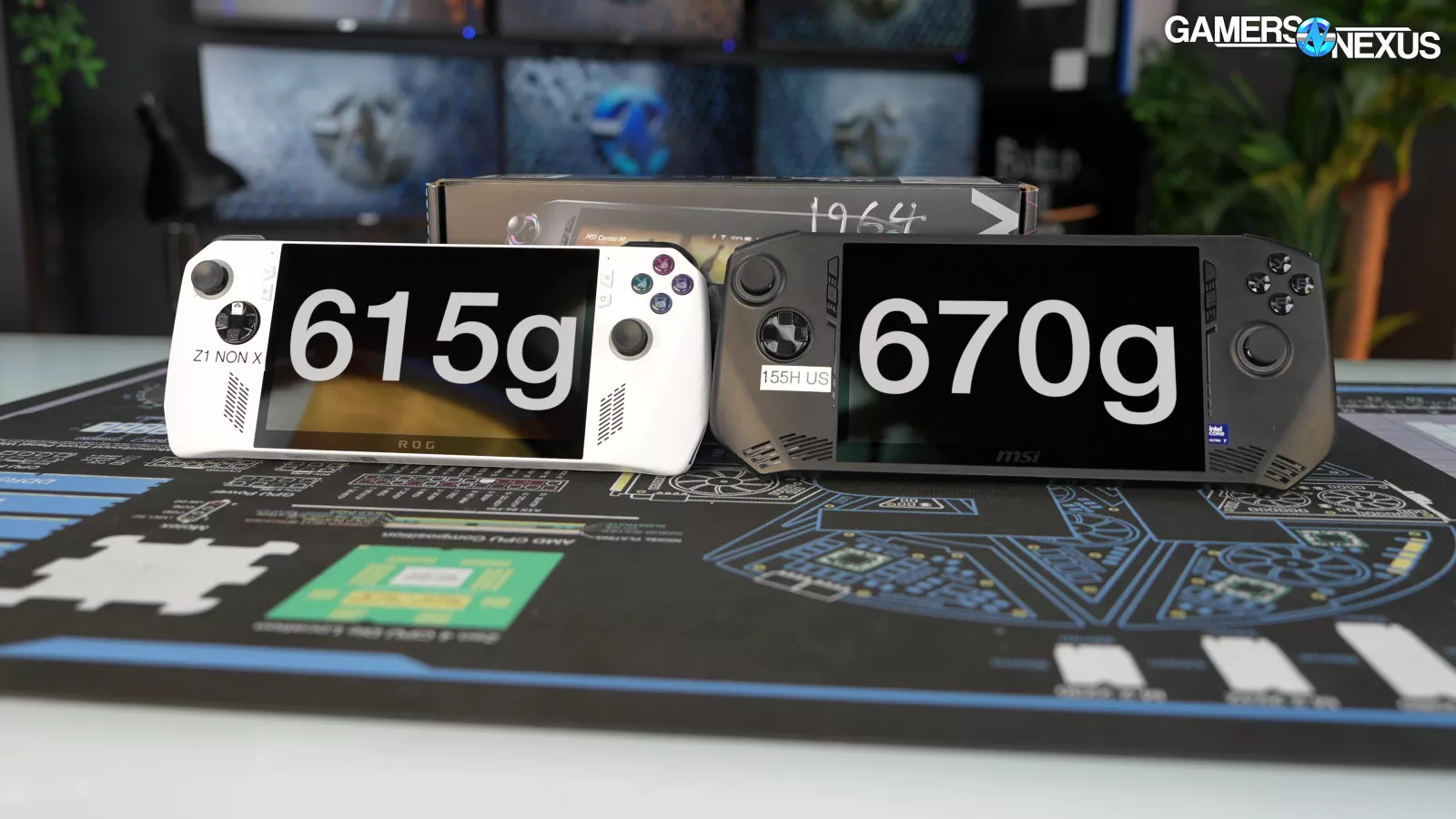
The Claw's weight is higher than that of an Ally, 670g by our measurements versus 615g, probably due to the Claw's larger cooler, which MSI calls the "CoolerBoost HyperFlow."
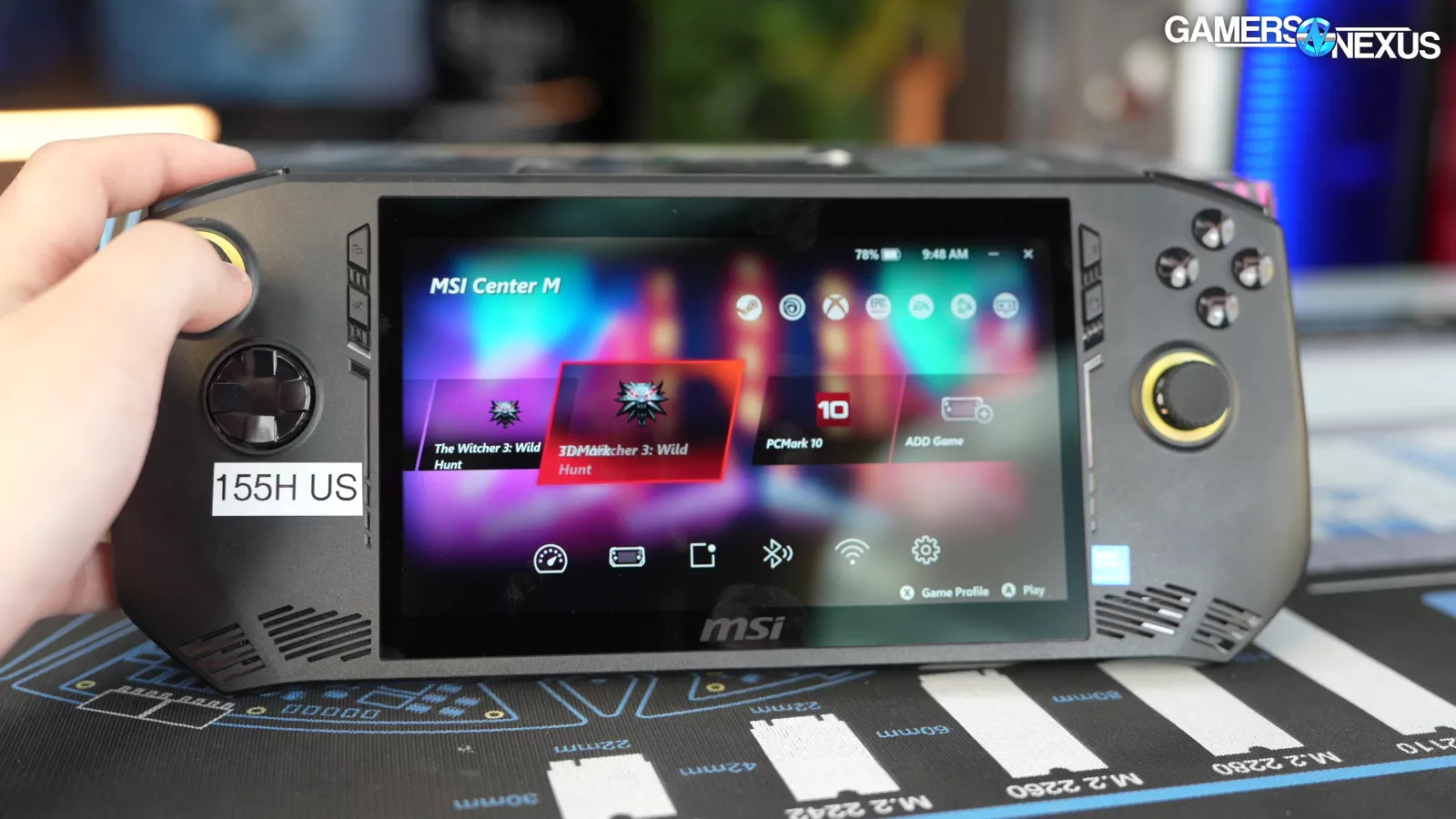
As for control differences, the Claw comes with Hall Effect joysticks out of the box, which is a plus, but negated by the bumpers.
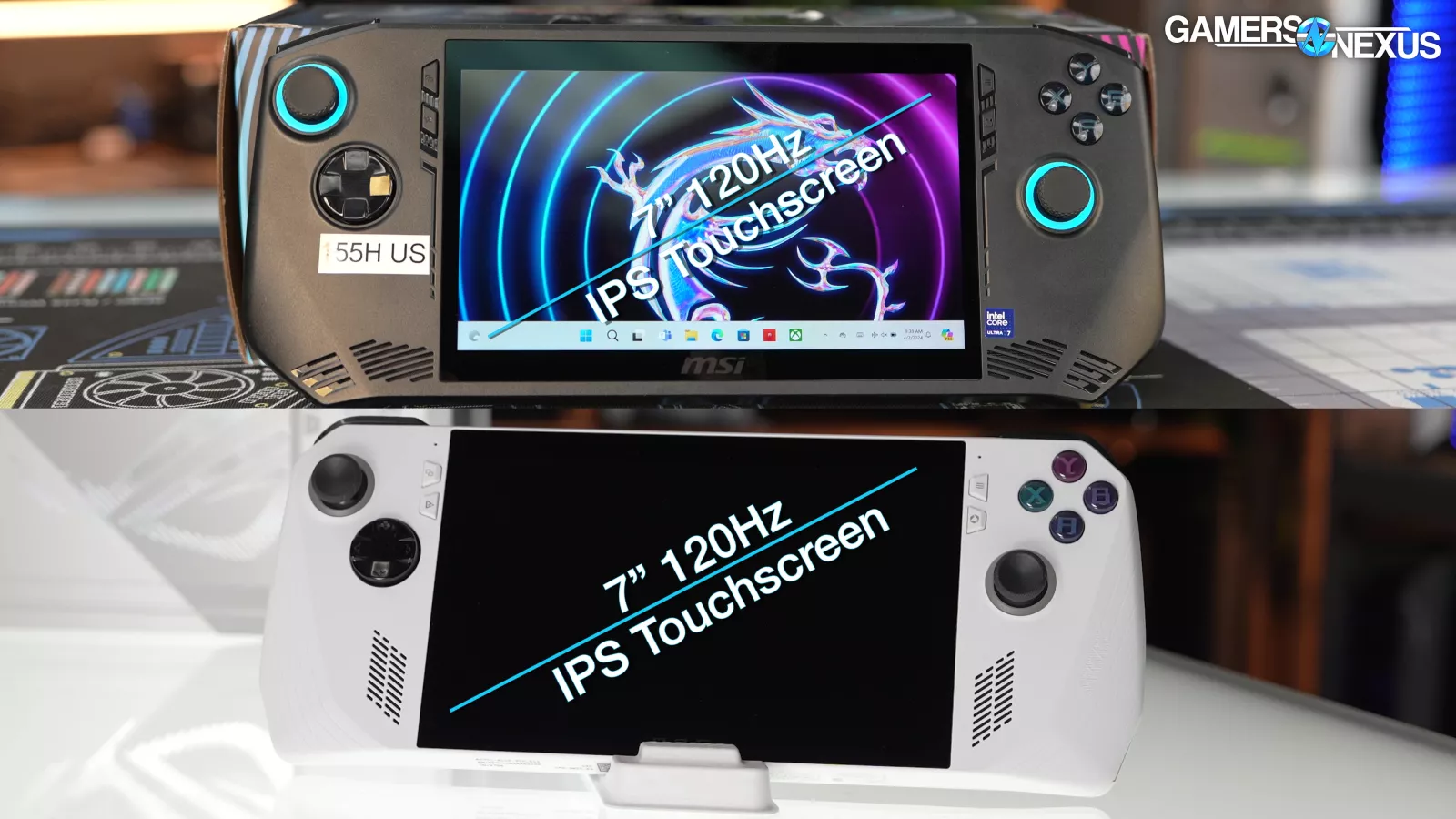
We suspect MSI is using exactly the same 7" 120Hz variable-refresh IPS touchscreen on the Claw, because even the bezels are precisely the same size as the ROG Ally, although as a whole, the Claw is approximately 0.5cm taller and 1cm wider.
Let’s get into the hardware comparison.
MSI Claw Hardware
We want good competition with the Ally because it's becoming harder for us to recommend it. The Ally Z1X is still arguably the best choice for a new handheld, and the massive price drops on the Ally Z1 make it a compelling budget option, but during our testing for this review, we had more problems with the Ally than any other device.
We had to reset Windows on the Z1 in order to get any updates to install. One year in, we already have a defective thumbstick, a rapidly degrading battery, and a broken microSD card slot unless we want to send it out for warranty.
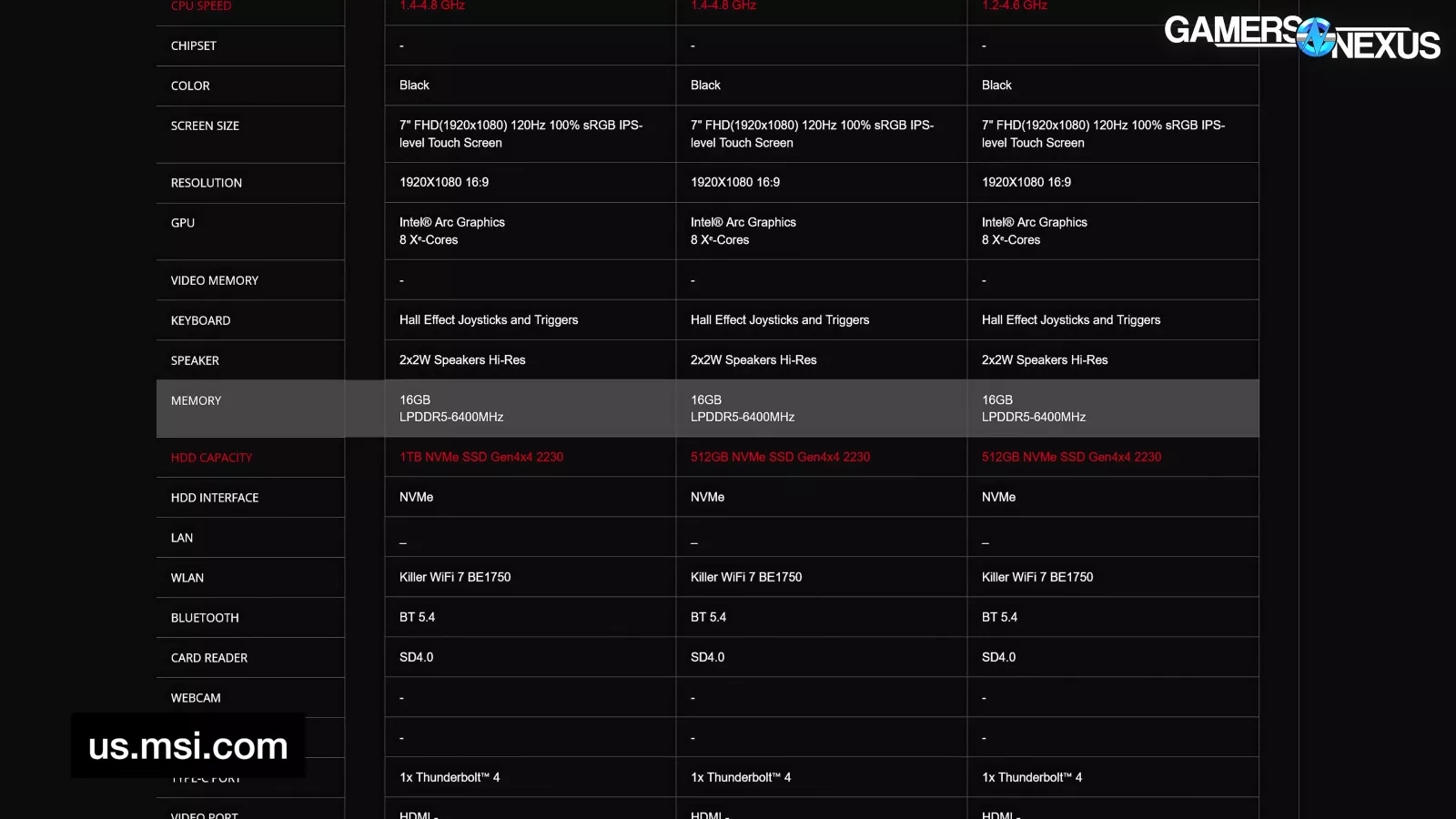
So let’s examine the Claw’s hardware. All Claw variants come with 16GB of LPDDR5-6400, just like the Ally and Deck OLED (read our review here). Like those devices, the Claw is only compatible with relatively expensive M.2 2230 drives, but the top tier has a 1TB SSD out-of-the-box rather than the Ally's max of 512GB.
Disregarding the drive size, the Ultra 5 model might deserve consideration if it were meaningfully discounted. The Ultra 5-135H contains 8 RT-capable Xe-cores, just like the 155H, clocked slightly lower to 2.2GHz rather than 2.25GHz. The CPU core count drops from 6P/8E/2LPE with 22 threads to 4P/8E/2LPE with 18 threads, but we expect handhelds to be GPU bound most of the time. That’s good news for these, as the GPU component is almost the same. We haven't tested the 135H, but on paper, it's less of a downgrade than the Z1 versus the Z1 Extreme.
The Claw lacks a dedicated eGPU port like Oculink or ASUS' proprietary not-Oculink port, but it does have a Thunderbolt 4 port. That's "a" port, singular, yet again. The Claw isn't an exception here, but having a single port for charging and I/O has proven extremely annoying on both the Deck and the Ally. We were hugely appreciative of what Lenovo did with the Legion Go, which was the utterly mind blowing concept of adding a second USB port.
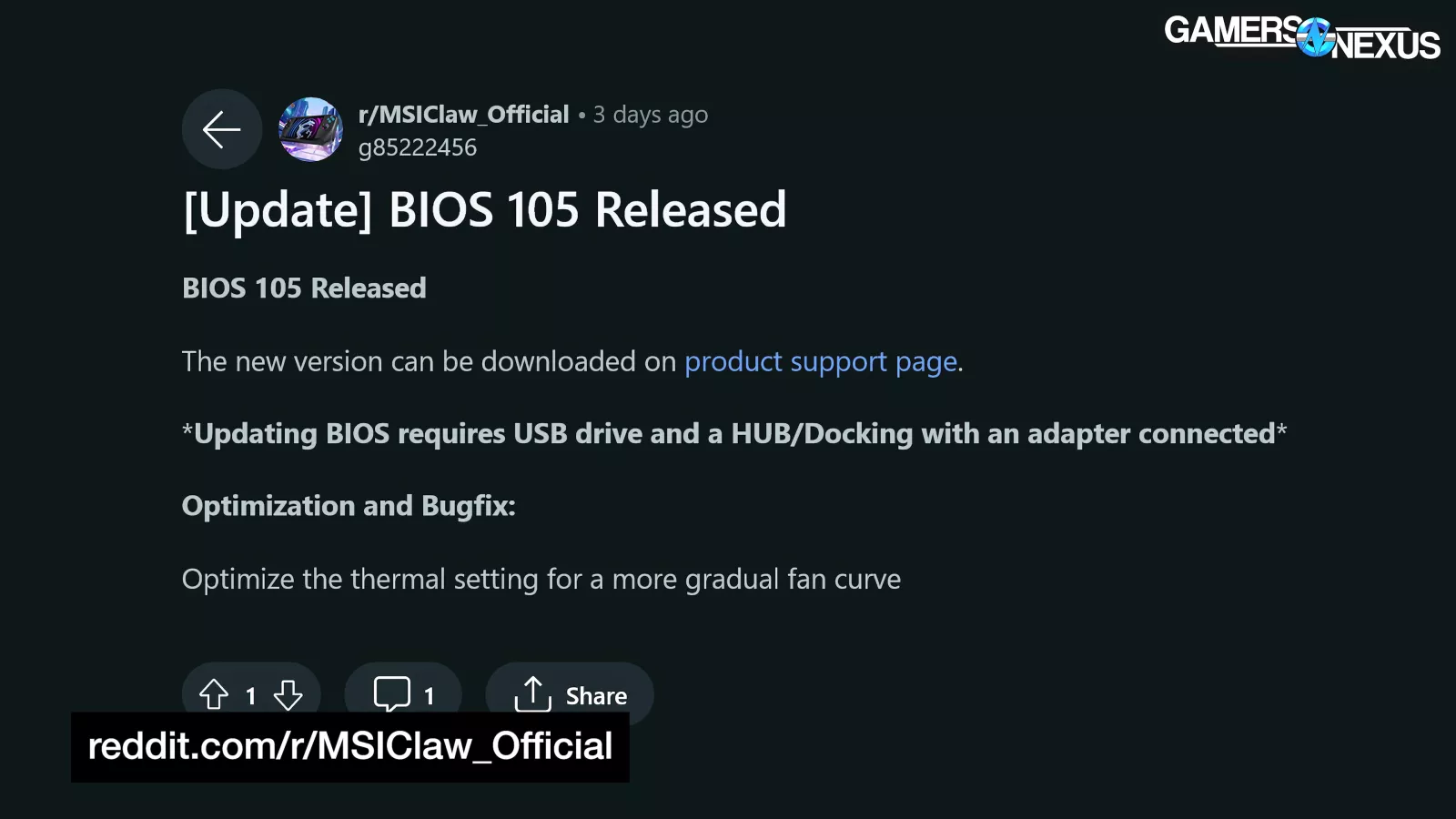
According to MSI, you'll need a powered hub in order to update the BIOS. They say, "Updating BIOS requires USB drive and a HUB/Docking with an adapter connected."

MSI does sell an $80 Nest Docking Station, but it recommends upgrading to a 100W charger in order to use it. One tiny feature worth praising is the tactile bumps that have been molded above the USB and microSD slots, making it easier to tell them apart in a dark room.
MSI Claw Software
Software is make-or-break for these devices, so it’s time to move to that.
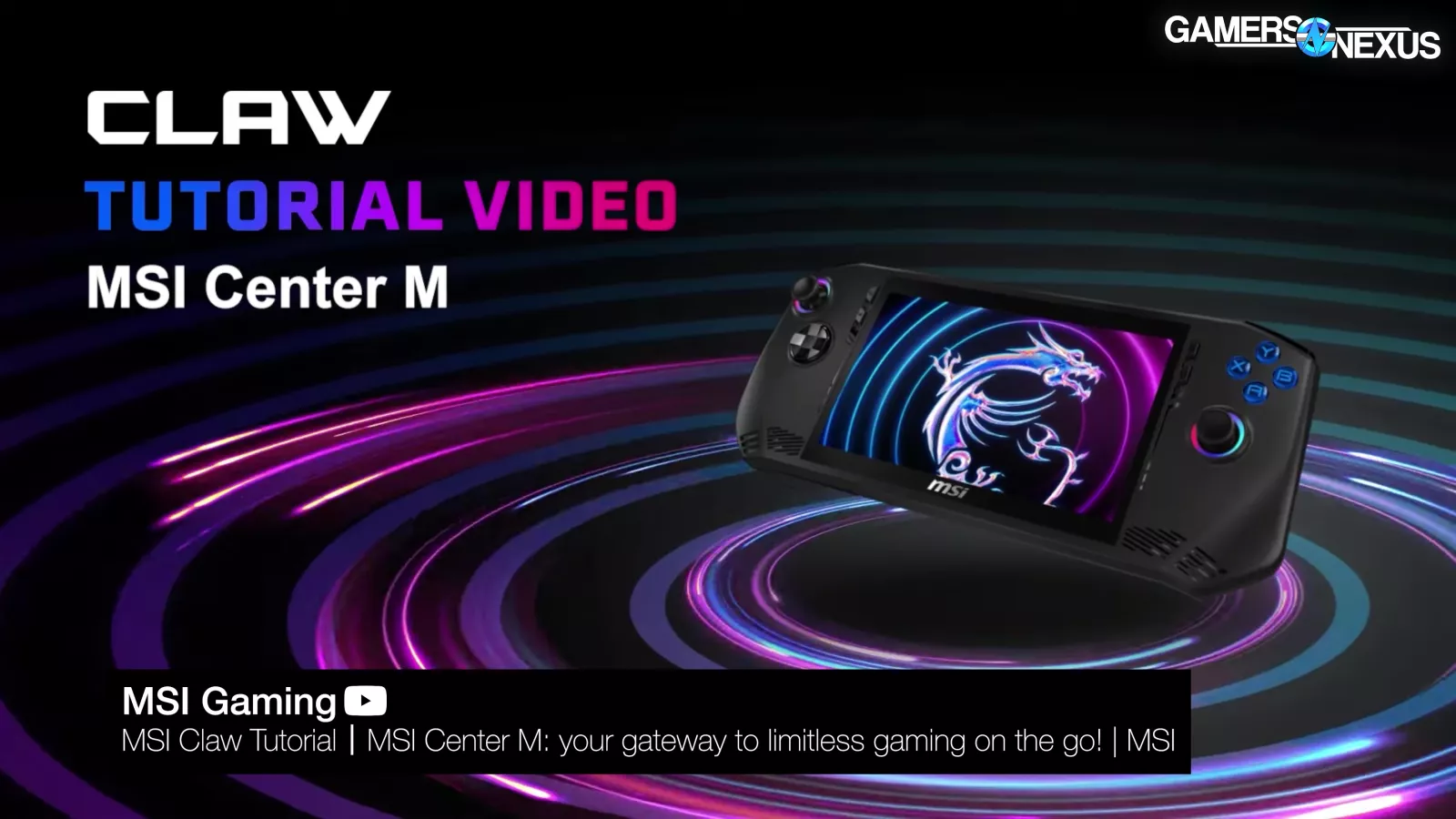
The inevitable manufacturer front-end software on the Claw is called MSI Center M. If you’re familiar with MSI’s recursive acronym naming, like the MSI MEG, MAG, and MPG, where all the Ms stand for MSI and so we have the MSI MSI Performance Gaming, then we can also assume the MSI Center M is basically the MSI Center M[SI]. MSI really needs some more words that start with “M” other than “MSI.”
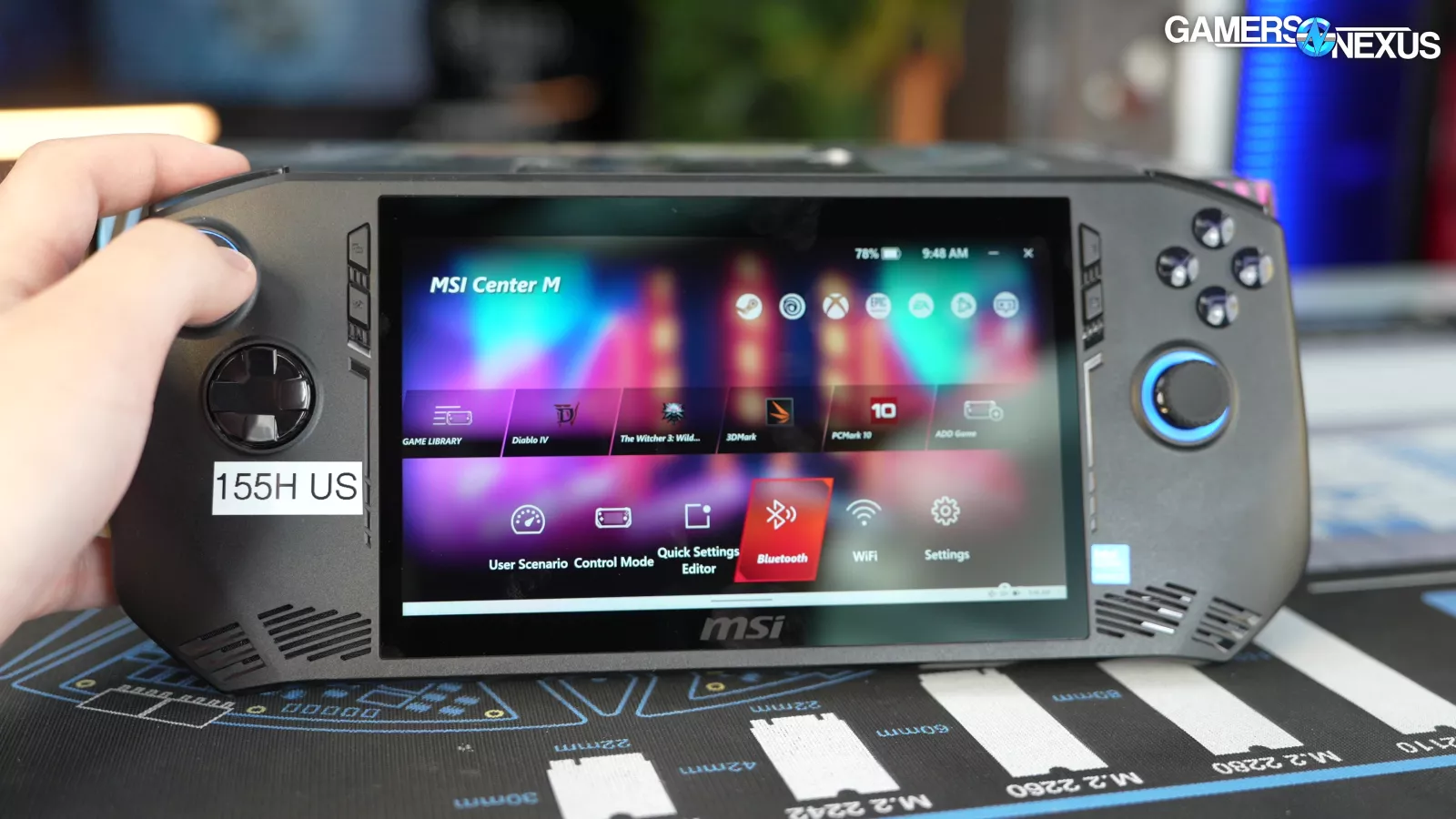
The UI is clumsy compared to the more mature software from Valve and ASUS. We ran into problems immediately upon turning the device on, too: if you don't open the software on boot, opening the overlay for the first time will bring up the main window and trigger an interrupt. Once the overlay is open, tapping the B button doesn’t close it. We also had some problems with the overlay not intercepting clicks, meaning that menus behind the overlay would be activated when in fact you are trying to click on the interactive pop-out overlay. In general, the software doesn't respond to input logically; or when it does, it can be difficult to navigate and feels like it was retrofitted from a desktop rather than built ground-up for a handheld device that has different inputs.
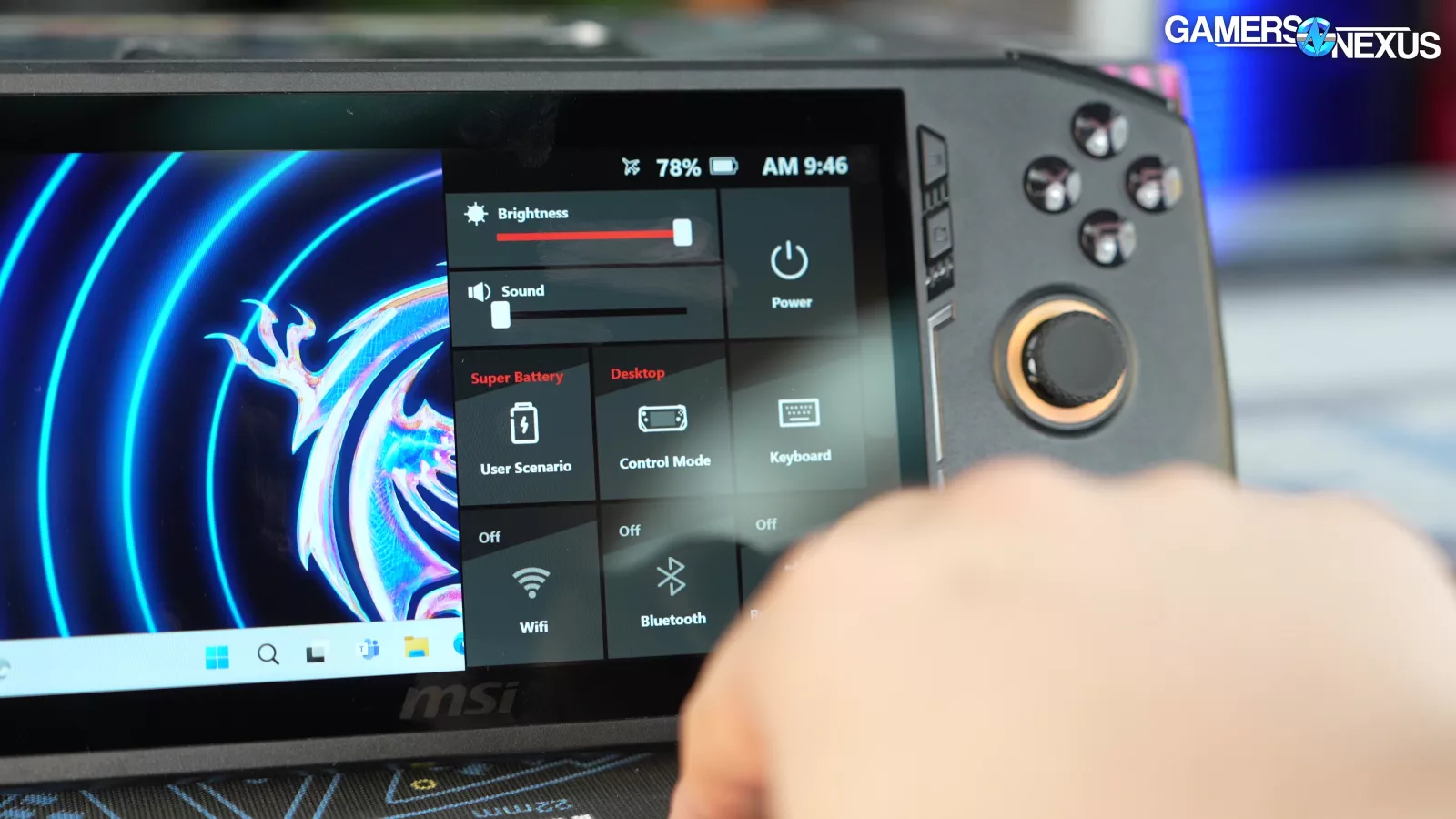
The most important aspect of the software is the so-called "User Scenario," which is maybe indicative of MSI’s other software problems: The names are often nonsense or convey little to no meaning to the user. What “User Scenario” actually does is change the power profile.
There’s Extreme Performance (AKA “Performance”), Balanced, Super Battery, Manual, and AI Engine. These profiles just set good old Intel PL1 and PL2 values that we’ve detailed in the past, although adjusted for this silicon. We liked that the Performance profile also offers the option to individually customize fan curves for each of the two fans, which is a great feature that MSI decided not to logically apply anywhere else at all: It isn’t available in any other power modes, again reinforcing a sort of half-assed approach that their developers can probably navigate thoughtlessly, but actual users end up with an inconsistent and unclear experience. In fact, even the MANUAL mode doesn’t support fan curve adjustment.
Conversely, Manual offers the ability to set PL1 and PL2 from 20W-40W on wall power or 20W-35W on battery power, but none of the others offer this. "Maximum Turbo Power" for the 155H is listed as 115W on Intel Ark, but we can understand why that definitely wouldn’t work for this handheld. Still, this is a decent level of customization, and the ability to set custom power profiles based on whether a charger is connected is a big deal. We’d like it if MSI unified the software options.
We secured an official table of the predefined PL1 and PL2 values for each power mode (also visible through HWiNFO). DC is battery power and AC is connected to a charger.
| DC | AC | |||
| PL1 | PL2 | PL1 | PL2 | |
| Super Battery | 20 | 20 | 20 | 20 |
| Balanced | 30 | 30 | 35 | 35 |
| Extreme Performance | 35 | 35 | 43 | 45 |
Table provided directly by manufacturer
Of the predefined profiles, Performance changes the most significantly based on whether a charger is connected, and it exceeds the values that can be manually set through the Manual profile -- yet another inconsistency in MSI’s interface. Super Battery also disables the Claw's RGB lighting, a decision we agree with.
If you're looking for help or information like this, it may have to come directly from MSI support if they even have the answer. MSI has three resources: the official guide, the official subreddit, and the official forum. The guide is moderately helpful, but the subreddit and the forum are both abandoned wastelands -- all of one month after launch -- because nobody bought Claws. As of this writing, the largest Ally subreddit has ~70,000 members to the Claw's 92. 92 total, not thousand. 92. Even the relatively niche Legion Go (watch our review here) has a larger community with 29K members, and that community regularly makes feature requests that are granted by the software team.
But now we get to the secret feature. The number-one, guaranteed sales-generator: Two special letters strapped to a noun, we have MSI’s long-awaited "AI Engine."
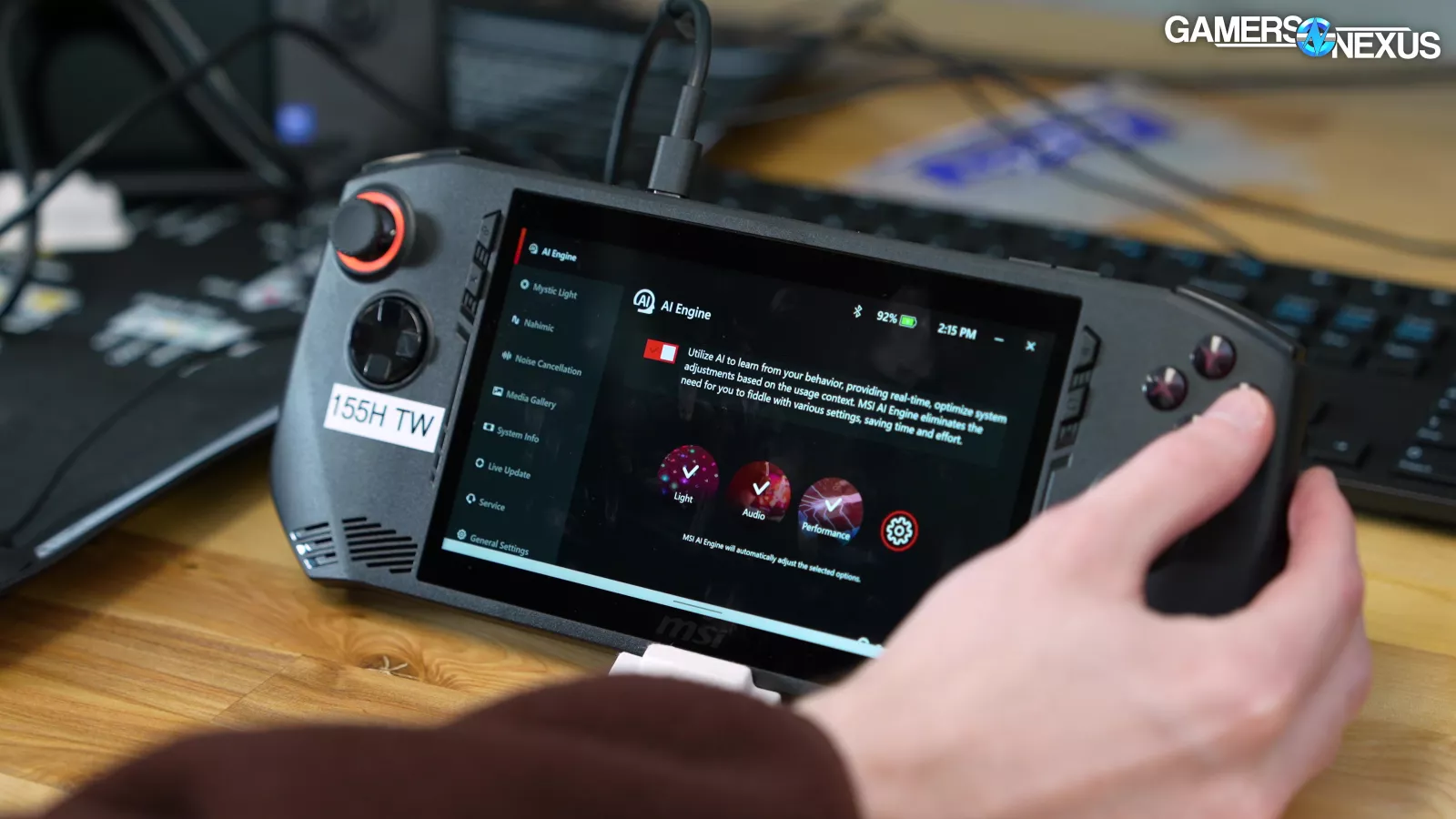
MSI says that it automatically switches between profiles for three things: the power modes we just described, Nahimic audio, and RGB lighting modes.
Now, you might be thinking: Wait a minute. That’s 3 things with some sub-options, which sounds like a simple matrix that could be handled with a lookup table. But…
Moving on! It seems like the idea is that if you launch a game, the device will swap to appropriate power, sound, and lighting modes automatically. We say “seems like” because it isn’t really clear how or if it works, or what “working properly” might even mean.
Intel Graphics Command Center was installed out of the box, but Intel Arc Control was not, even on the review sample that MSI had screwed around with and we decided not to use. Even when updates are delivered through MSI Center M, some of them just get unceremoniously dumped in the downloads folder. This is expected behavior though for Center M.
MSI has left display-related controls to Intel and Microsoft, which means there's no battery saving refresh rate cap available through MSI Center M.
There is a BIOS function. BIOS appears to be a normal MSI laptop setup, but without any performance controls beyond the ones accessible within the OS. It's definitely not as feature-rich as the Go's BIOS: there's enough functionality to navigate a Windows install, but that's about it—that is, until you hit the secret right control+right shift+left alt+F2 key combo to open up the real BIOS controls, including the ability to set ratios, disable cores, or do anything else you'd normally do in a desktop BIOS. Accessing the BIOS already requires holding RB+RT during boot, so we're not particularly happy to see MSI hiding additional functions beyond a second hidden key combo.
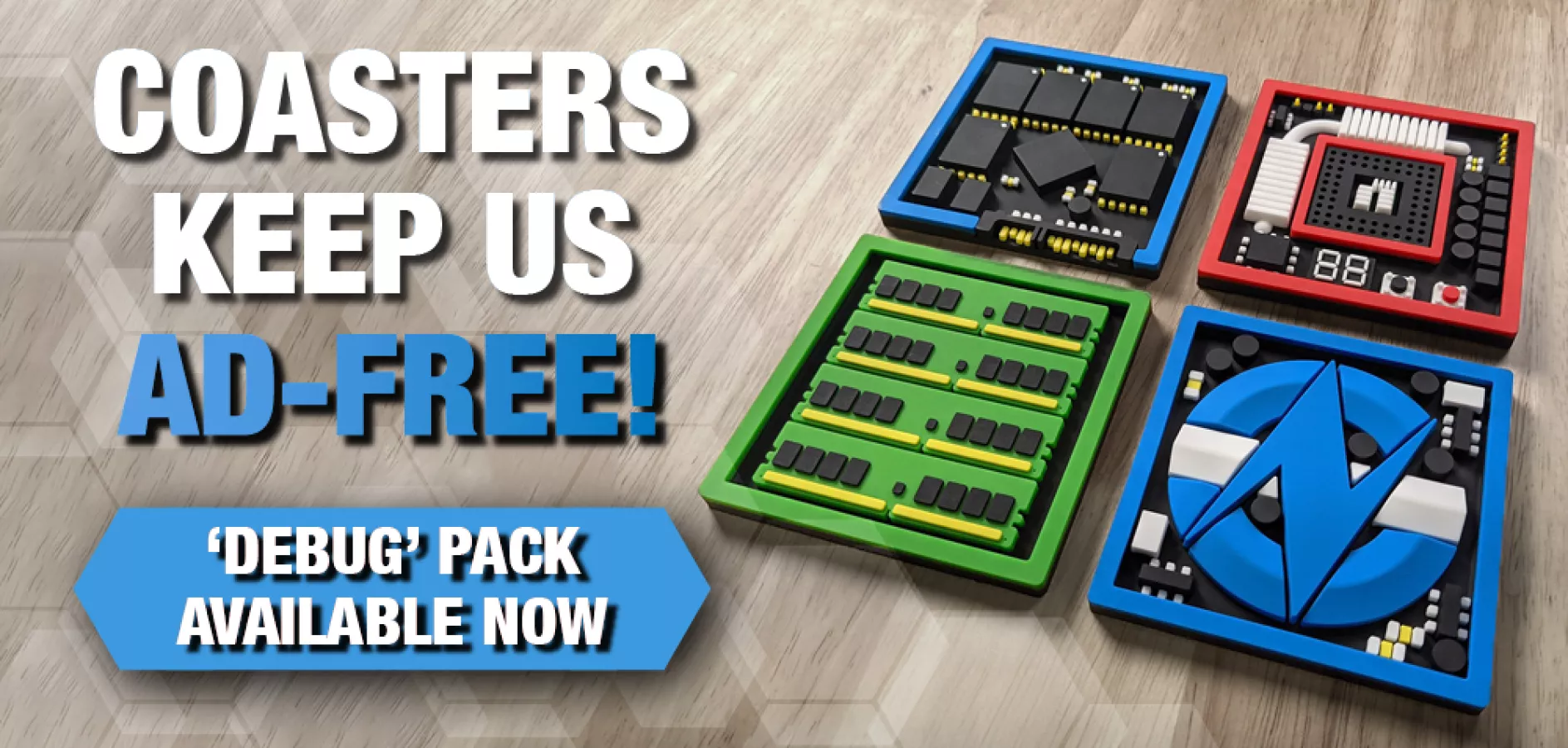
MSI Claw Battery Life
Our first set of benchmarks is for battery life.
The Claw is equipped with a 53Wh battery, the largest we've tested so far, although it's essentially tied with the Deck OLED and Legion Go. All automatic power saving features like screen dimming were disabled for testing. For now, we set a 50% screen brightness; however, this is one of our only uncontrolled variables in testing since 50% can be different things on different screens. Our future testing includes nits normalization.
F1 23 (720p, no VRS, no framerate caps)
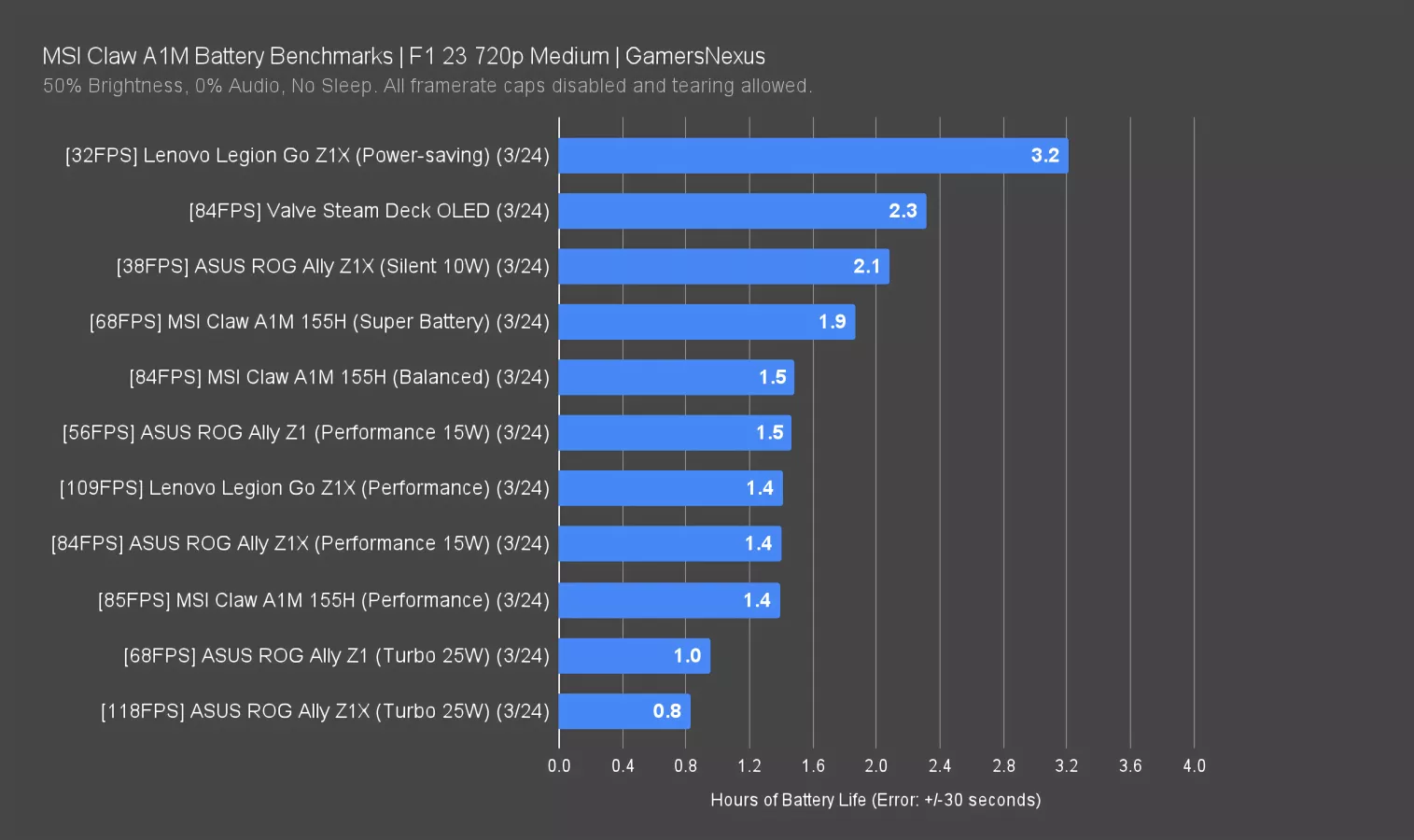
This chart is super interesting: We’ve added AVG FPS in the benchmark next to the devices, then battery in the bar. Remember that this doesn’t tell the full story, so we’ll look at lows later. It allows us to start showing performance and battery life, since both are critical.
This test uses F1 with the framerate cap disabled, but resolution enforced on all devices. We have a chart with performance results using the same settings coming up, which will give us a look at efficiency.
This is a super cool datapoint that we haven’t seen discussed elsewhere much: The Claw’s ASUS Z1X competition ran for 2.1 hours in silent at 38 FPS, not much of a performance contender, and 1.4 hours with Performance with 84 FPS AVG. The Z1 Performance and Claw Balanced are equals for battery life, which means that normalized for battery drain, the A1M is actually far superior in this specific title. Its normalized advantage is around 50%.
The heavier workload allowed the Claw's power profiles to differentiate themselves, but even here, there's only a five-minute improvement between Performance and Balanced. They’re just not that different. Reducing the profile to Super Battery significantly extended the Claw's battery life, up 35% from Performance and at nearly 2 hours, but that does come with a hit to FPS. The drop is from 84 FPS AVG to 68 FPS AVG between balanced and super battery, meaning that balanced performs about 24% better for FPS. More on that soon.
The Go's power-saving profile tops the chart, but at an unplayable frametime consistency that makes it irrelevant. The more useful comparison is in Performance mode, where it holds 109 FPS AVG at 1.4 hours of life. The Deck OLED is a chart leader here, up at 2.3 hours for 84 FPS AVG. Normalized for FPS, the Ally Z1X in Performance also held 84 FPS AVG, but at a reduced 1.4 hour battery. That means the Deck OLED lasts 64% longer at the same FPS in this specific test. Impressive.
Dead Cells (Native Device Resolution, VSynced Native Device Refresh Rate)
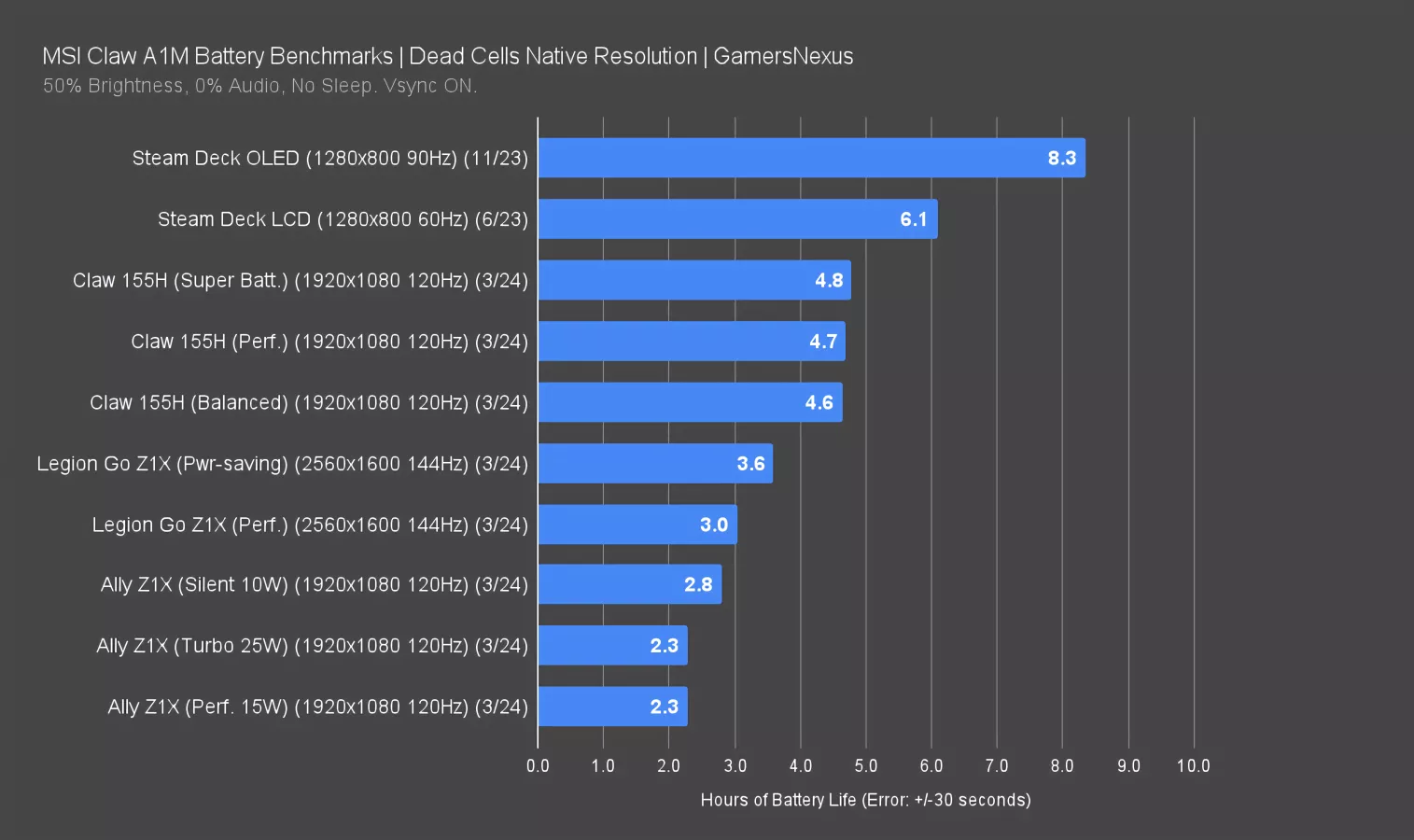
Our next battery life test is Dead Cells run at the native resolution and v-synced refresh rate of each device. This is intentional and represents normal use. The Claw's performance is good among the high-refresh devices we've tested, although there's no specific improvement between Performance and Super Battery modes. The Super Battery power limit is too high to show a significant advantage with this light workload as compared to the AMD devices, which have stricter limits, and the Performance and Balanced results are within variance of each other. The Claw's best time was 4.8 hours in this test, which gives it a real advantage over the Ally Z1X's best of 2.8 hours, obviously helped by the larger battery. Because this test allows native resolution and refresh, the Legion Go is disadvantaged and falls behind. The Ally, however, loses in a scenario closer to a like-for-like and has the worst battery life of all these devices.
The Steam Deck OLED comes out on top by a huge margin at 8.3 hours with its large battery and efficient screen, although its relatively low resolution and refresh rate also help it here, and the same applies to the Deck LCD.
But there’s more to it than that, and that’s what our gaming tests are for.
MSI Claw Gaming Benchmarks
For our gaming tests, all FPS caps and variable refresh features were disabled. All tests were performed on battery power unless specifically marked as wall power, and all tests using wall power were done with the battery 100% full. Only manufacturer-defined power profiles were used. Remember that profiles are named arbitrarily by manufacturers: "Performance" on the Ally is not the same thing as "Performance" on the Legion Go or the Claw. The Deck has no power profiles and does not alter performance based on the presence of a charger.
Resident Evil 4 (2023) (DX12, FSR2 Quality)
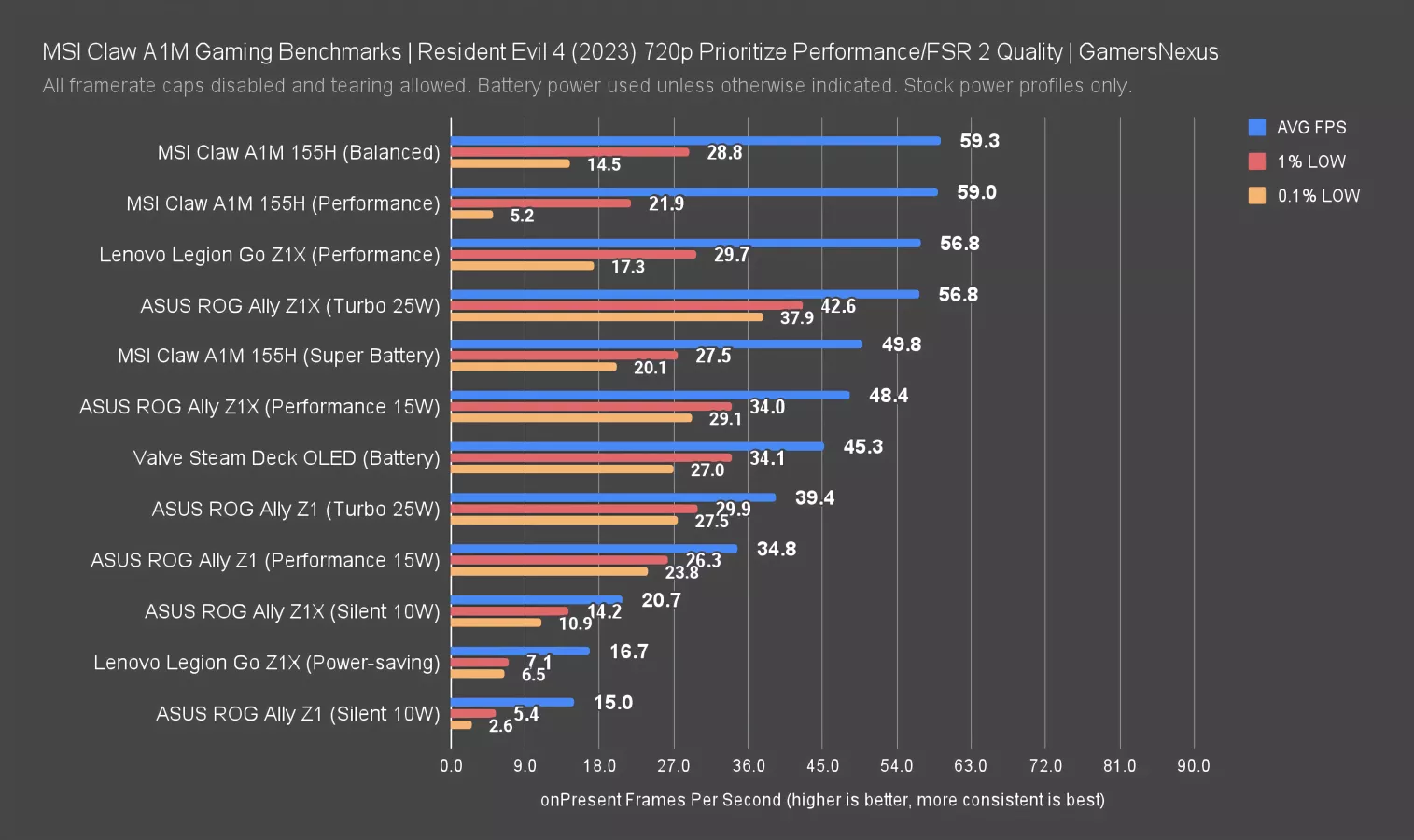
Resident Evil 4 was a title with frame pacing issues that are difficult to represent on a bar chart because of their inconsistency. We’ll look at a frametime plot for that later.
The Claw's Performance and Balanced profiles are tied for 59 FPS AVG, but although the Balanced and Super Battery profiles appear to have superior lows, in reality the run-to-run variance was high and all were equally stuttery. You cannot extract any meaning from the lows as the singular spikes blow out the averaging.
This instability overshadows the fact that the Claw is actually at the top of the chart in terms of average FPS, surpassing the Legion Go and Ally Z1X, and outstripping the Deck OLED by as much as 31%.
Frametime Plot
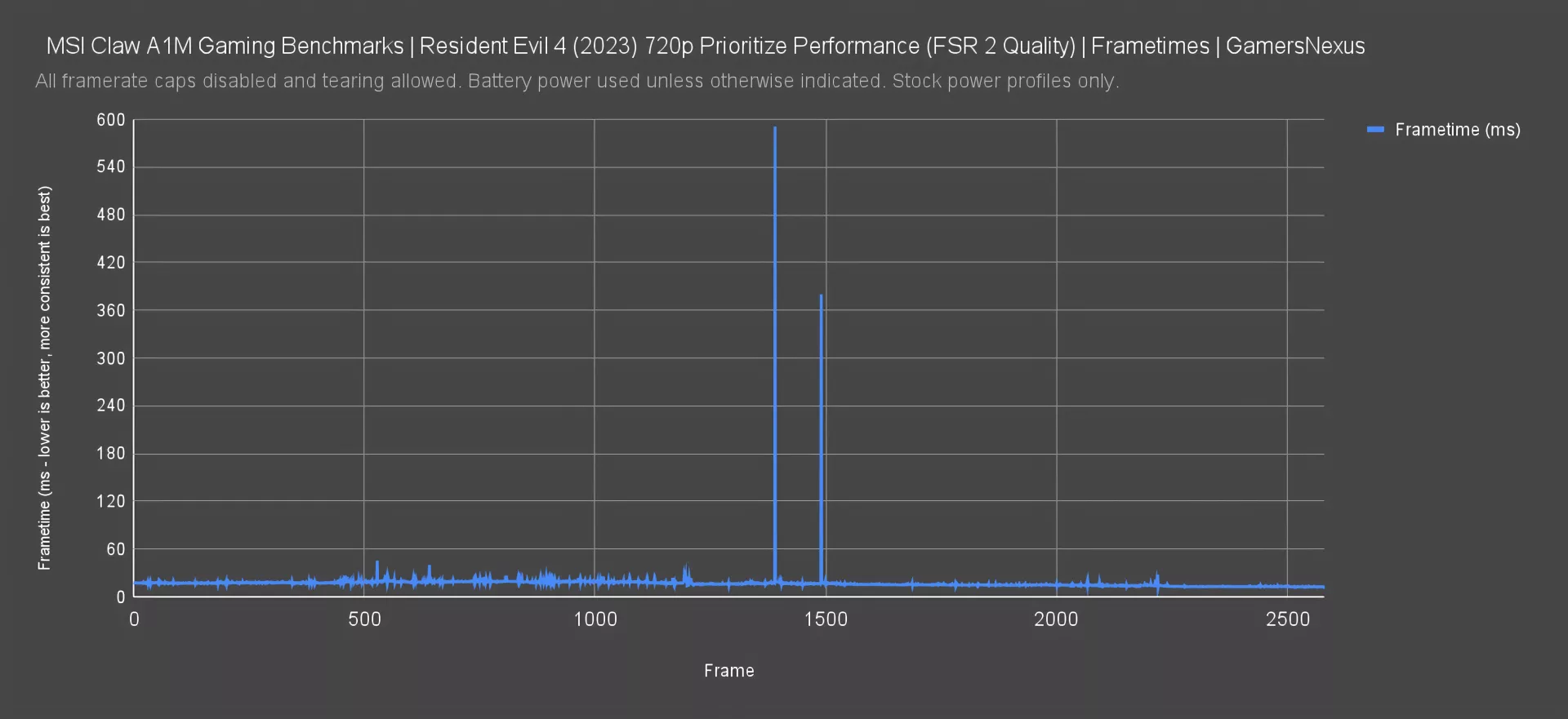
But none of that matters. Here’s where it gets really bad. This is a frametime plot. In this instance, the Claw ran into a seriously bad frametime spike to 600 ms and another at nearing 400 ms. A 600 ms frametime is clear as day to see and feels like a heavy stutter.
This is some remarkably bad frametime pacing and eliminates a lot of the AVG FPS advantages a device might have.
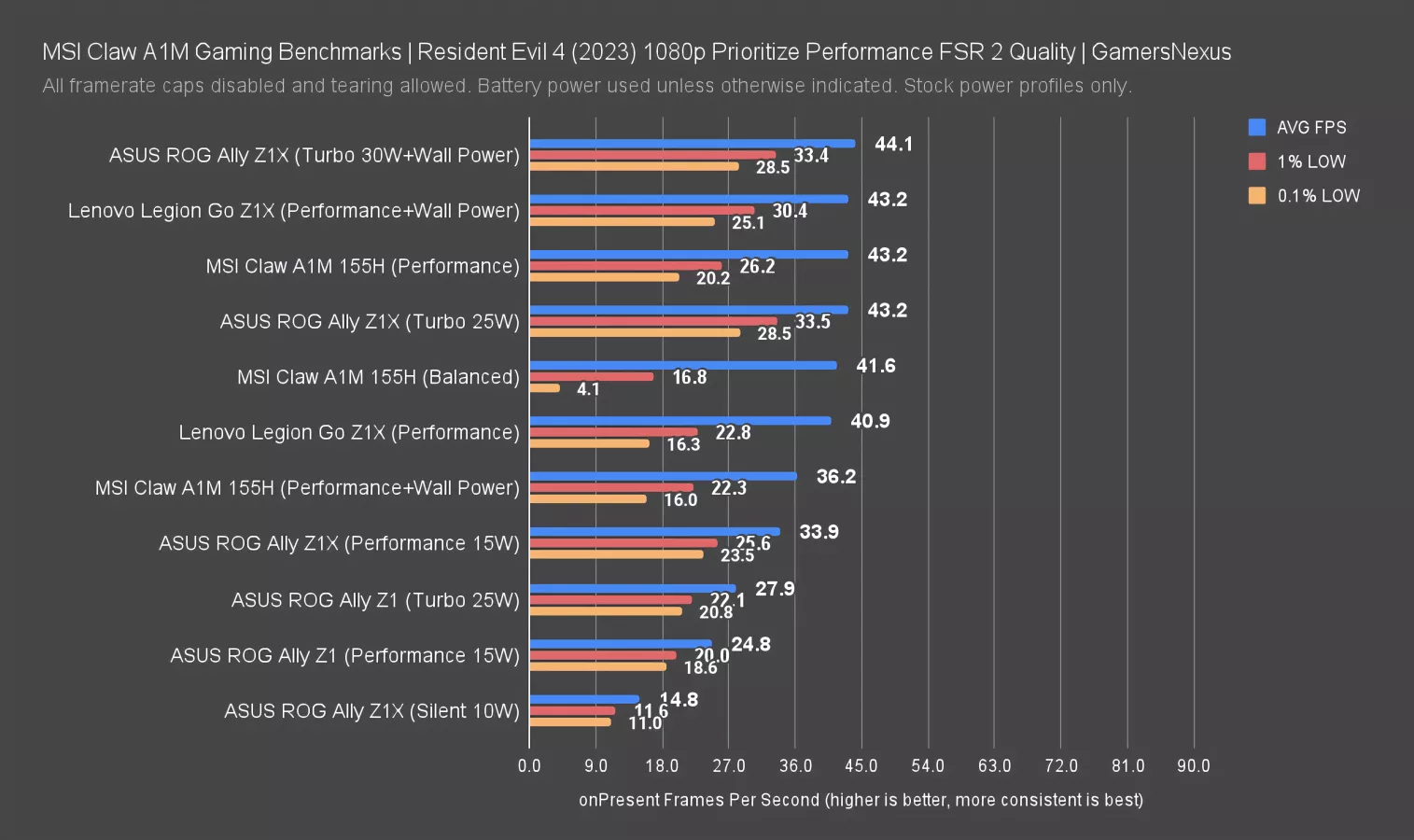
At 1080p, the Claw's frame pacing issues continue, making it difficult to get reliable results. The addition of wall-powered results pushes average performance for the Go and the Ally Z1X up to equal the Claw, but the top results on the chart all level out around 43FPS. The more stable pacing of the non-Claw handhelds make for a better experience here regardless of the overall averages, highlighted by the 4 FPS Balanced 0.1% low, which is terrible -- a result of a particularly nasty frametime spike.
Cyberpunk 2077 v2.12 (DX12, FSR 2.1 Quality or XeSS 1.2 Quality)
For Cyberpunk, we used XeSS on the Claw and FSR on the AMD handhelds, which is the same approach we take for GPU benchmarking. We set each upscaling method to an equivalent percent upscaling from source resolution that's 66% of the width and 66% of the height in Intel, AMD, and NVIDIA terminology.

Here’s the chart. Cyberpunk 2077 was one of the worst-performing games we ran on the Claw relative to the rest of the chart. We saw consistent hitching that persisted even when we exited the test area; unfortunately, the frametime inconsistency -- down at 3FPS for the 0.1% lows -- made the game unplayable in a way that the overall 30FPS average doesn't reflect. Some games will run terribly or not at all, and it's hard to predict which beforehand. That’s the nature of Intel Arc.
The Z1X handhelds top the chart here, led by the Ally Z1X's 25W Turbo mode at 59FPS AVG, with the Steam Deck OLED demonstrating its typically stable frametimes and its primary advantage, which is frametime pacing. Remember that for Asus, Turbo mode will drastically shorten battery life, and in this instance, you can expect a sub-1-hour battery. The more balanced Performance mode puts it at 41FPS AVG with a better battery time.
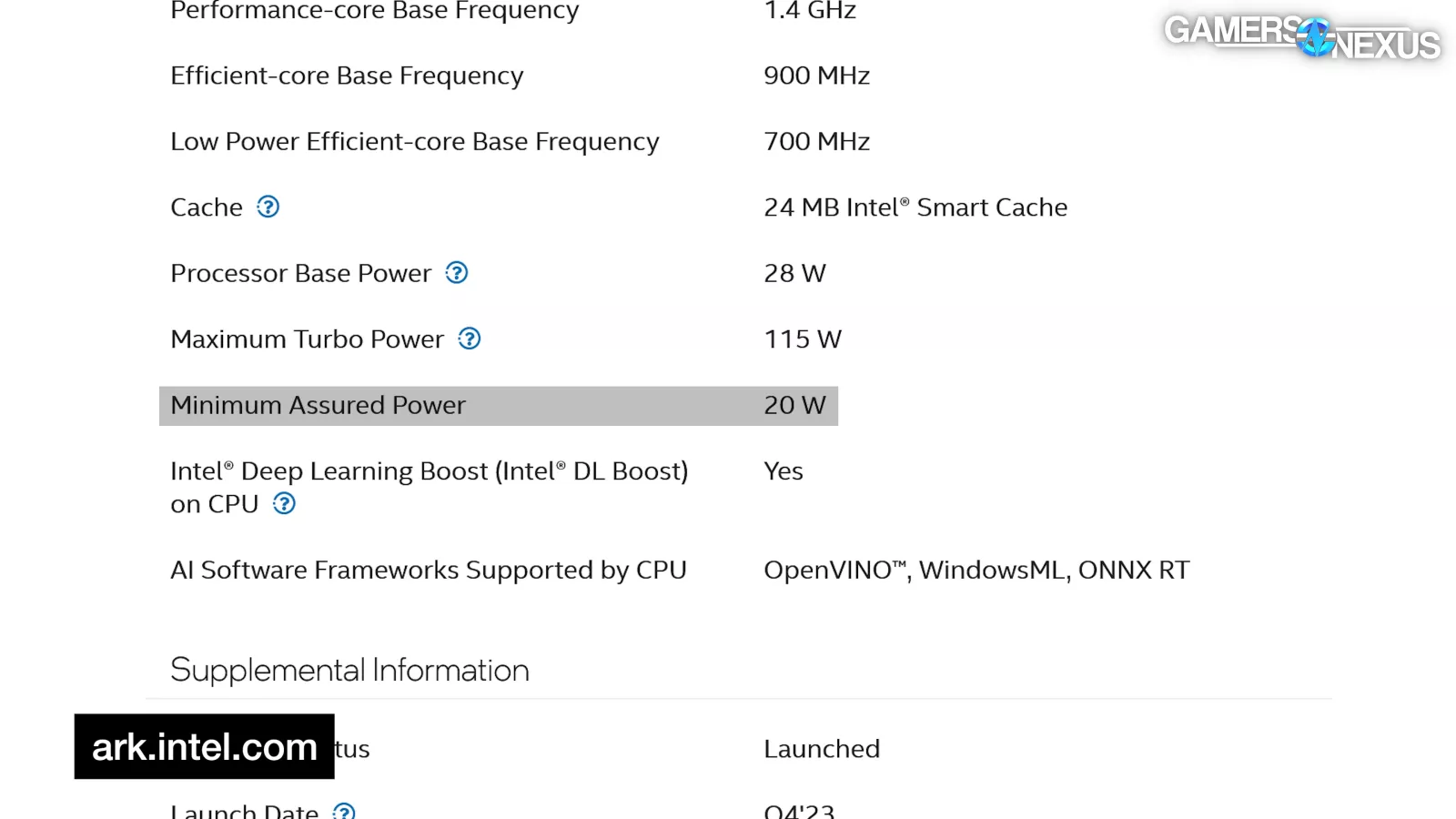
The low-power modes for the two Ally handhelds and the Go land at the bottom of the chart by a long shot. These modes aren't suitable for anything beyond 2D gaming. Meanwhile, the Claw's Super Battery mode isn't much worse than its Performance or Balanced modes: if anything, MSI could cut power further here if the Intel part supported it, but Super Battery is the lowest power level accessible through the UI, matching the "Minimum Assured Power" for the 155H on Ark. The Claw's Performance and Balanced modes are tied at about 30FPS, with the 5W power limit increase not enough to make a difference here.
The Z1 non-Extreme is about half the price we paid for the Claw and its Performance AVG FPS roughly equates the best Claw result, but with significantly better frametime pacing shown in the lows.
Cyberpunk 2077 1080p
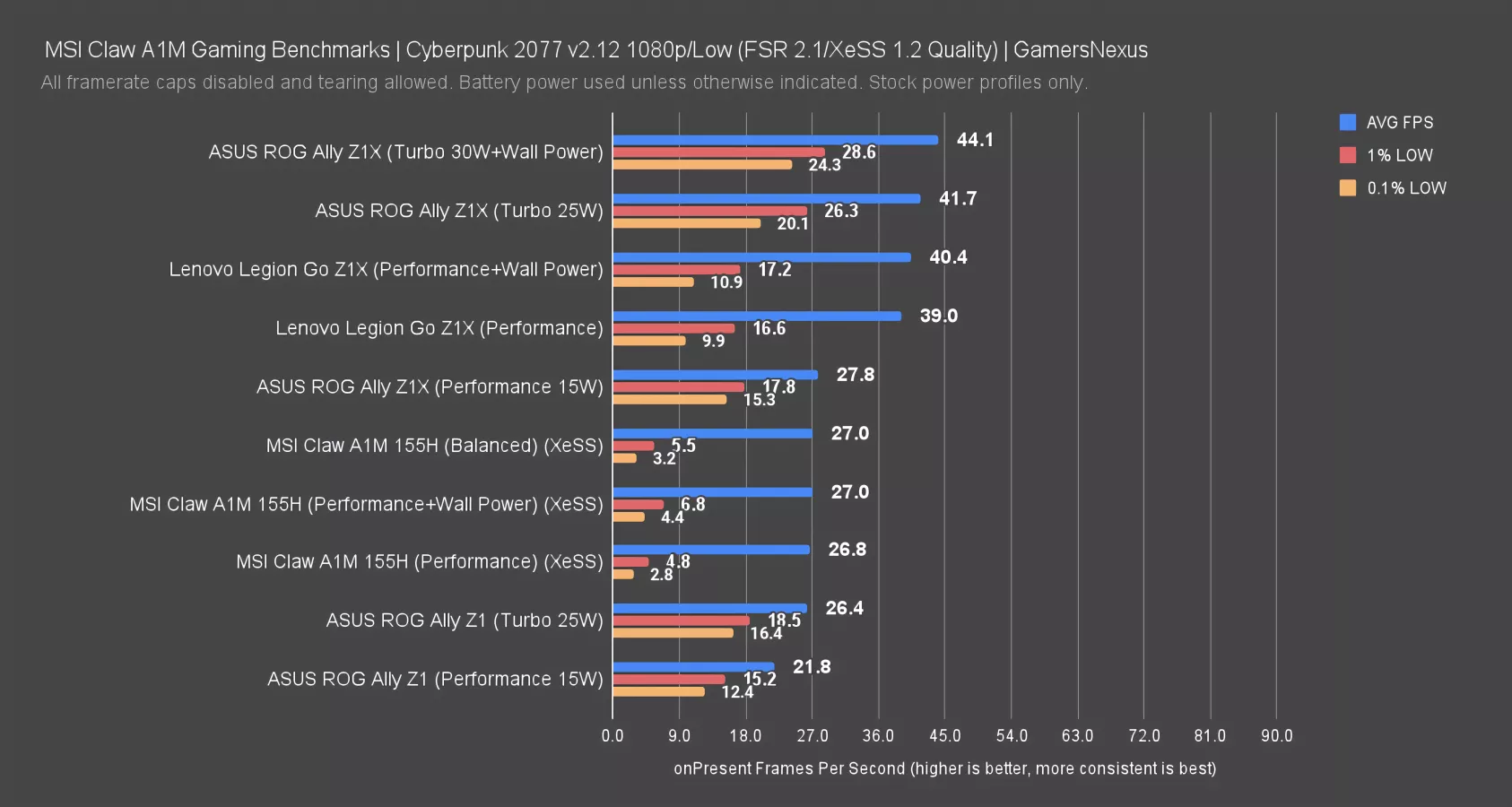
At 1080p, we drop the low-power profiles and add tests with wall power. The MSI Claw positioning remains the same. The bump to PL1 and PL2 from connecting the charger is irrelevant to its performance in this test, and the average remains 27FPS with the worst lows on the entire chart. They are consistently inconsistent, making for a consistently bad experience. This is in contrast to devices like the Legion Go and especially the Ally Z1X, both of which gain some additional performance when plugged in. The Deck does not benefit in FPS from being plugged in.
F1 23 (DX12, no variable rate shading)
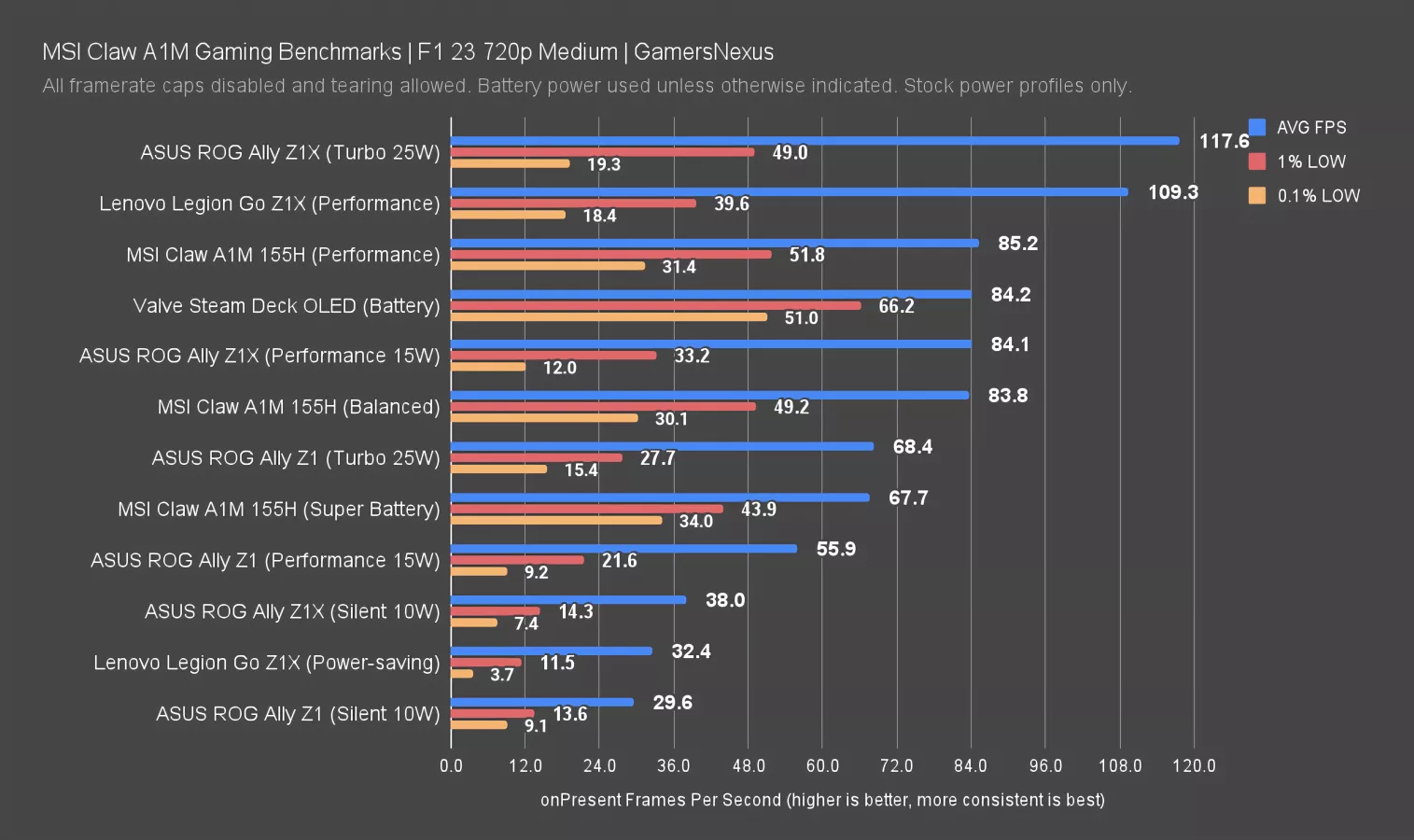
F1 2023 is up now.
These pair with our thermal and battery tests. The Claw is tied here in average FPS with the Deck OLED and the Ally Z1X's Performance 15W power profile. The Deck OLED remains the most consistent for frametime pacing, although the Super Battery A1M Claw result is more consistent than the flanking Z1 entries.
The two Z1X-powered handhelds pull significantly ahead with their highest power profiles applied at 118 FPS and 109 FPS, while neither the Deck OLED nor the Claw have any additional headroom.
Red Dead Redemption 2 (Vulkan)

Red Dead Redemption 2 Vulkan ran well on the Claw, with lows that compare favorably to the rest of the chart. The Claw's best-case 62FPS average is 7% ahead of the Ally Z1X's Performance 15W profile, although the Ally Z1X's battery-draining Turbo profile tops the chart at 66 FPS AVG.
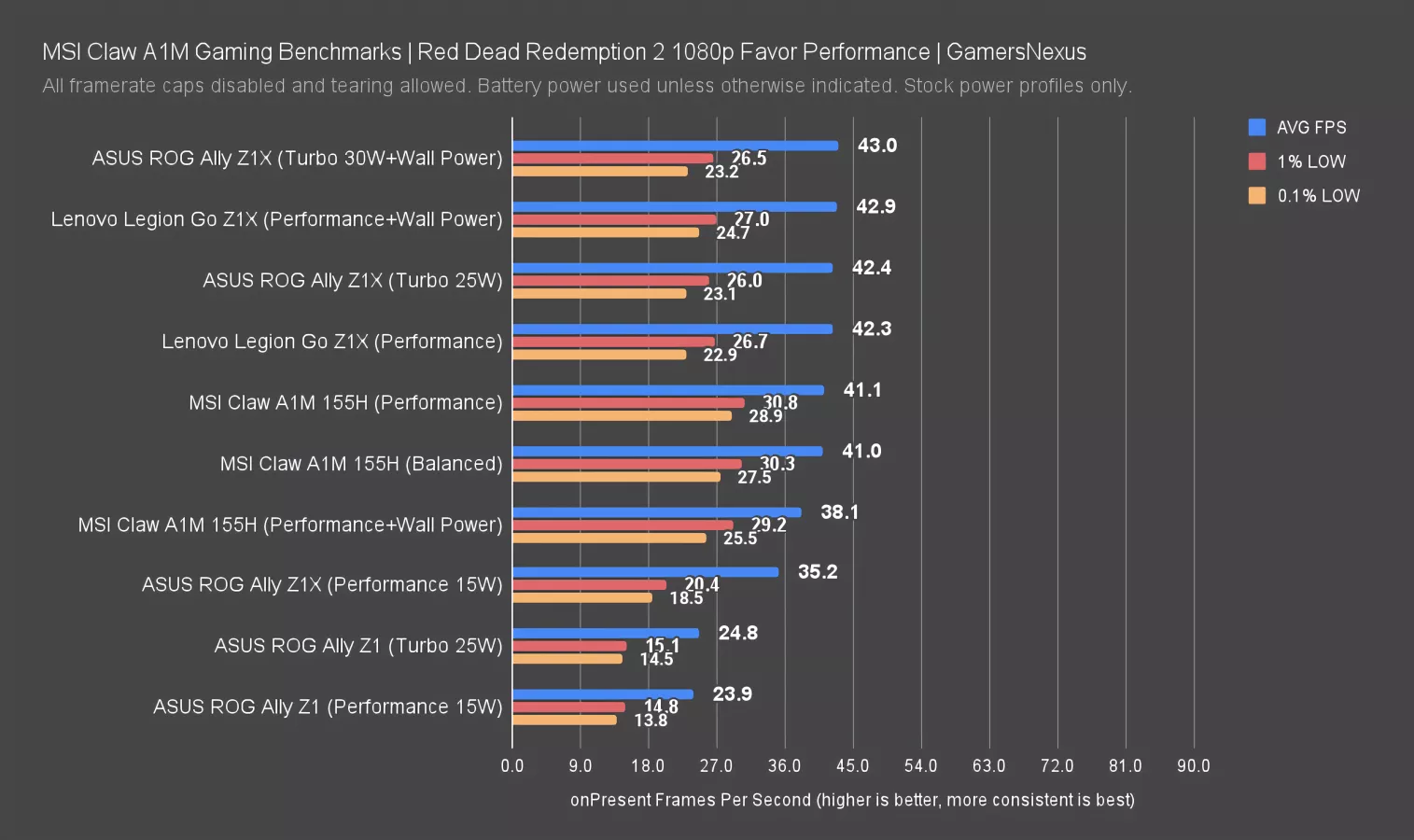
At 1080p, the Z1X-powered devices hit a clear limit around 43 FPS. Connecting the Claw to wall power resulted in a slightly lower average of 38FPS, which is a pattern we saw validated across multiple titles. More on that soon.
Baldur's Gate 3 (DX11, FSR2.2 Balanced)
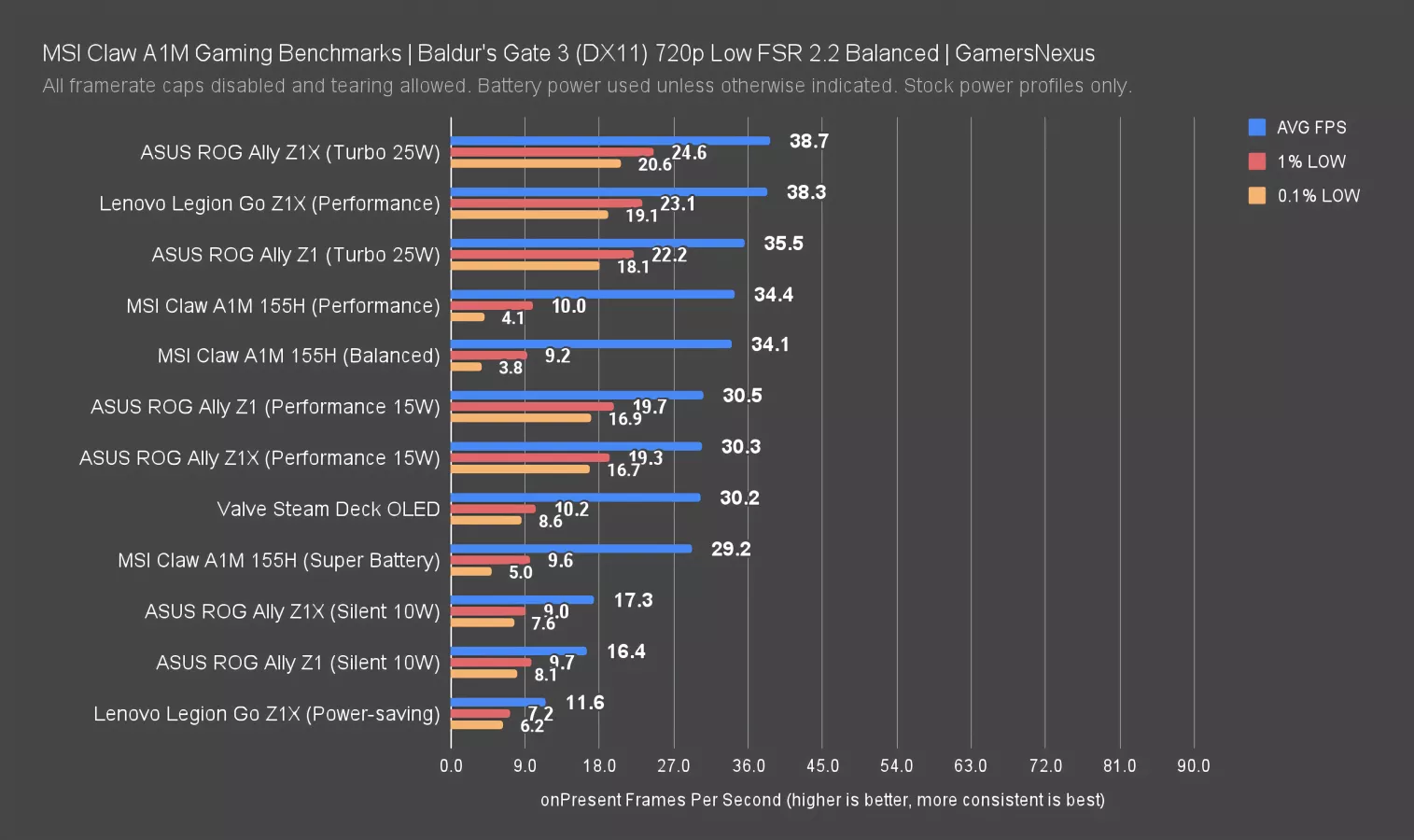
Baldur's Gate 3 reliably produces low 1% and 0.1% numbers, but the Claw has worse frame pacing than the rest of the entries on this chart. The Z1 non-Extreme does particularly well here, and on any given day, it's $400 cheaper than the Claw.
Dying Light 2 (DX12, async compute enabled, FSR2 Quality or XeSS Quality)

In Dying Light 2, the Claw's best of 49FPS is behind the Ally Z1X's best of 56 FPS with its Turbo profile and within variance of the Legion Go's best of 50FPS. Super Battery reduced the average framerate, with 24% improvement from Super Battery to Balanced.
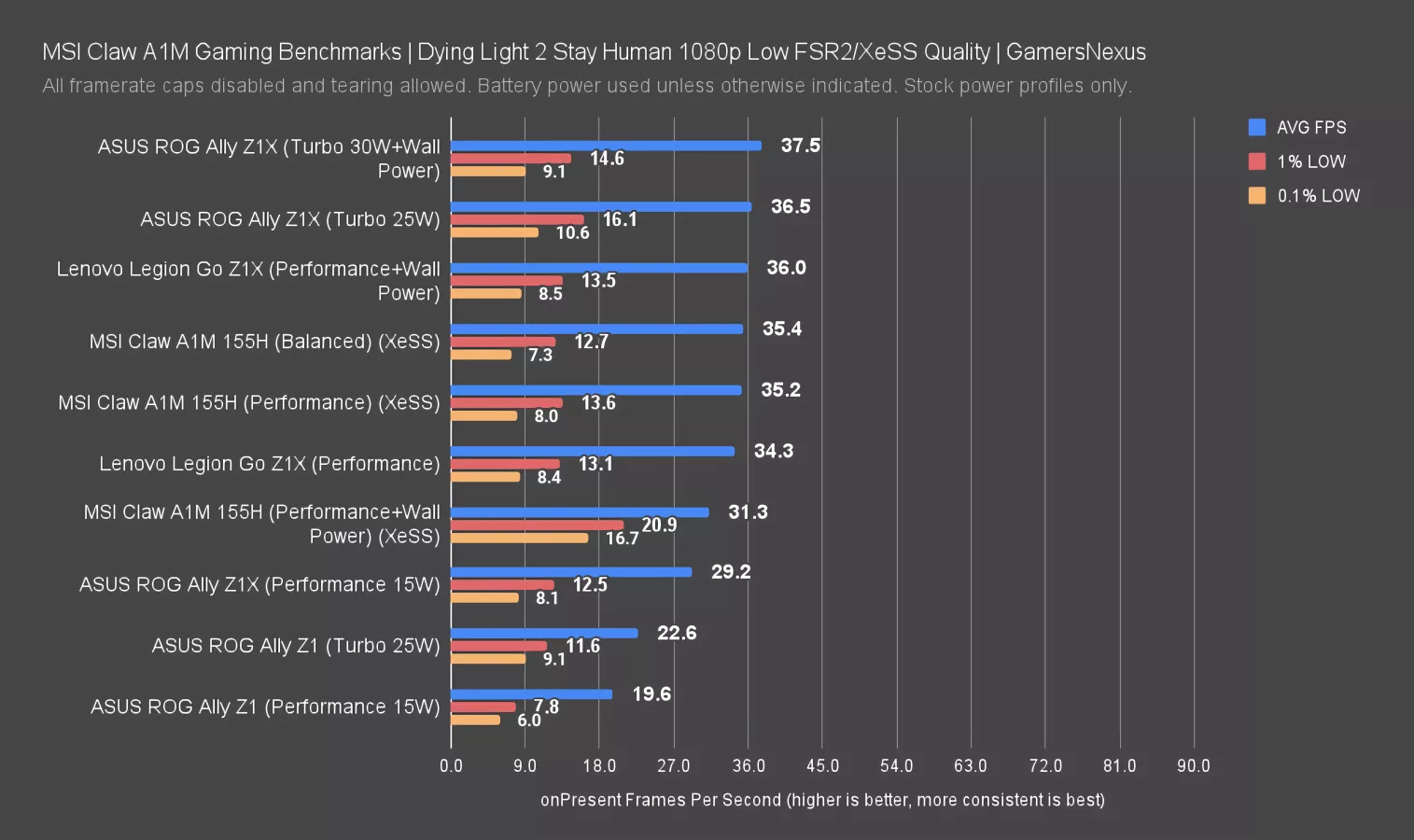
At 1080p, the Z1X and 155H devices begin to level off. The Claw connected to wall power with the Performance profile did worse than it did on battery power, which is behavior we saw repeated in other games.
MSI Claw Charging
Now for charging testing.
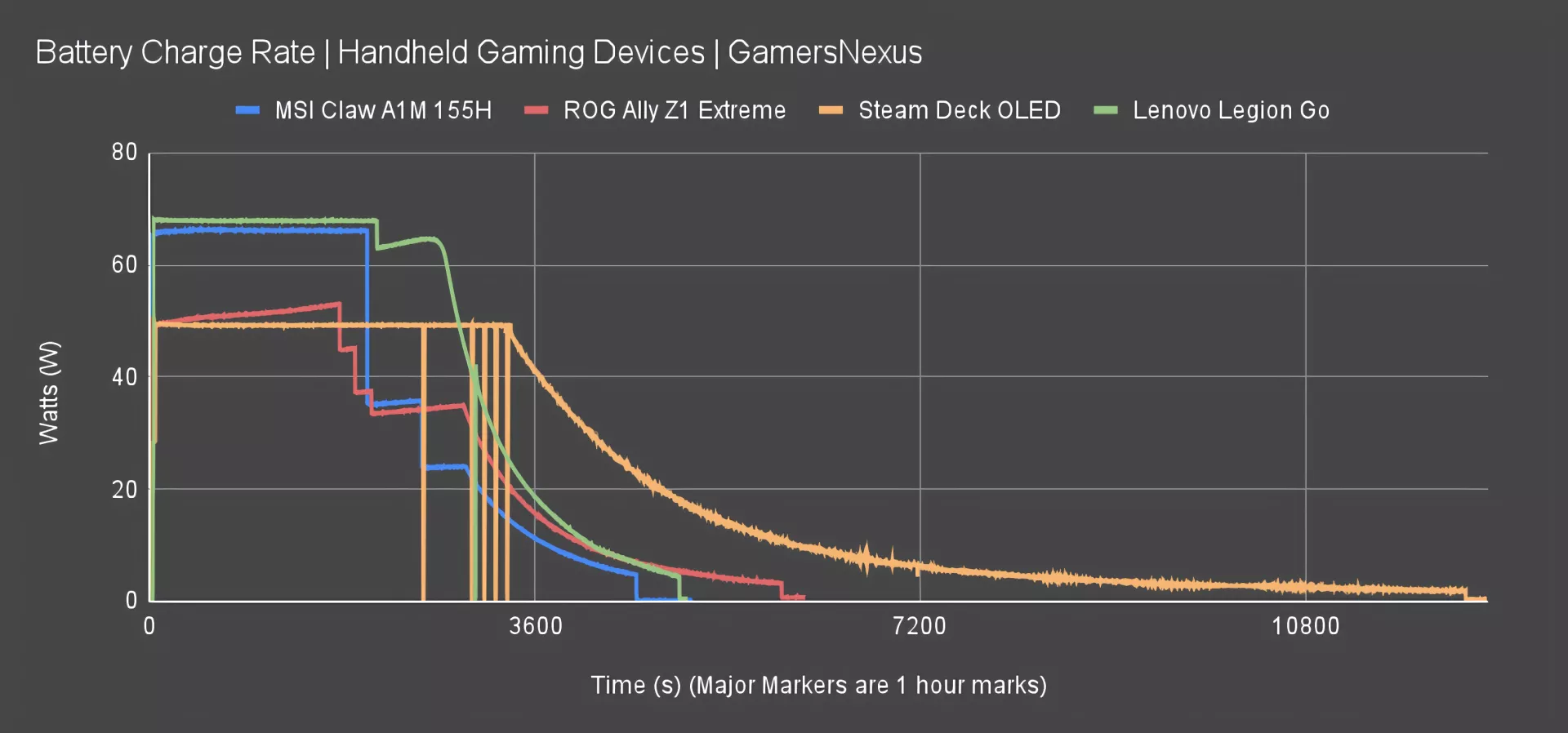
Our most basic charging test is done with each device fully powered off and dead enough to shut itself down. This testing is done with the included charger.
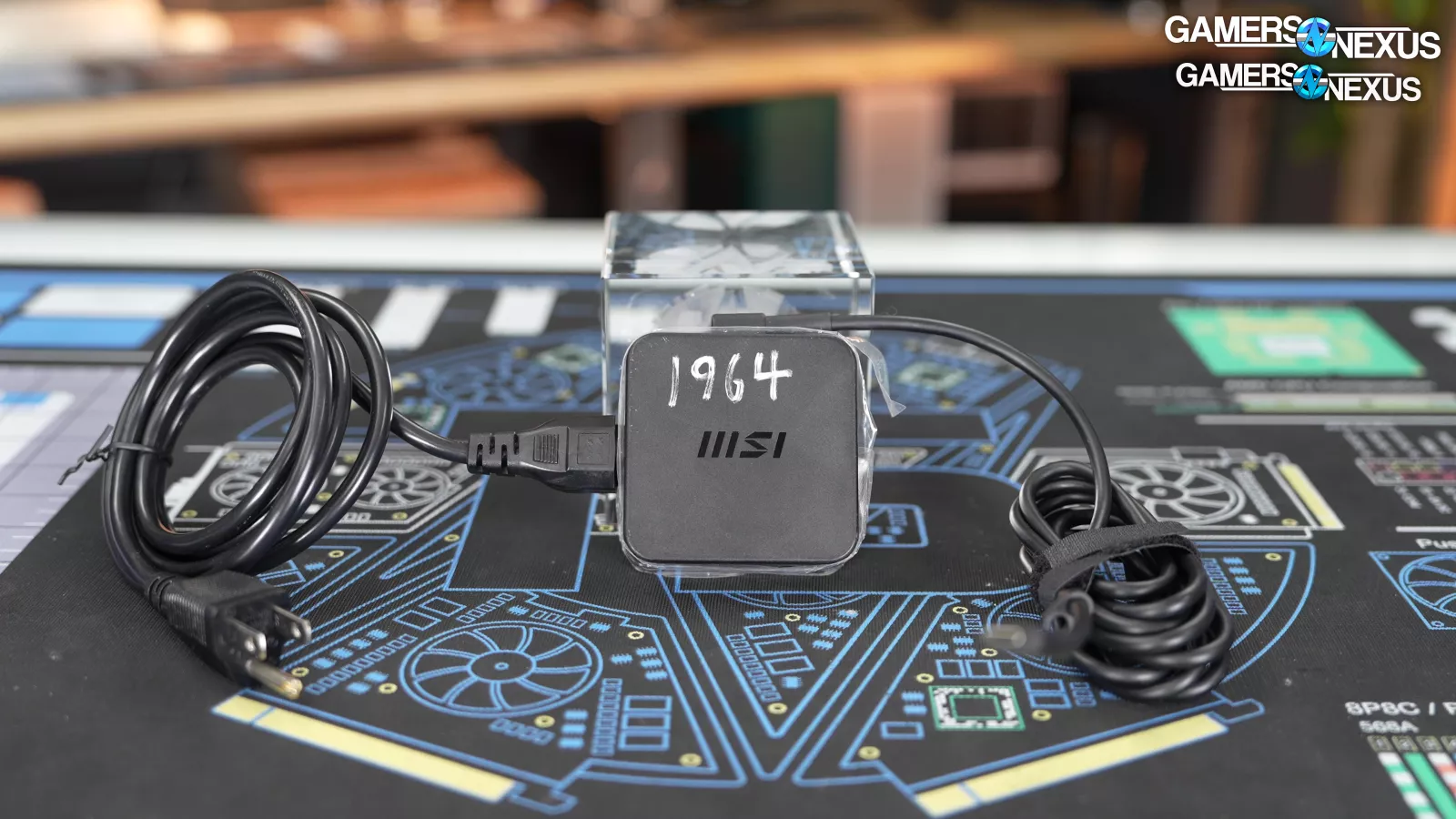
We consider the charger to be part of the product, so we measure its behavior in combination with the device.
The Claw started off pulling the full 65W capacity of its wall charger, just like the Legion Go, although the Go went a couple Watts beyond the rating.
Afterwards, the Claw settled into lower power thresholds before finishing completely at 76 minutes, the fastest charge time among the devices shown on this chart, which is impressive given that it also has the largest battery.

Here's a rough chart to illustrate that point, generated with some log data that we already had on hand. Note that this chart is truncated before the devices reach 100% charge. The point here is that the Claw follows a steeper curve than the other devices, shown by the hump in the line, storing more energy quicker. The Claw has the fastest charging rate among devices we've tested, but whether it can make efficient use of that energy is a separate matter.
MSI Claw Thermals
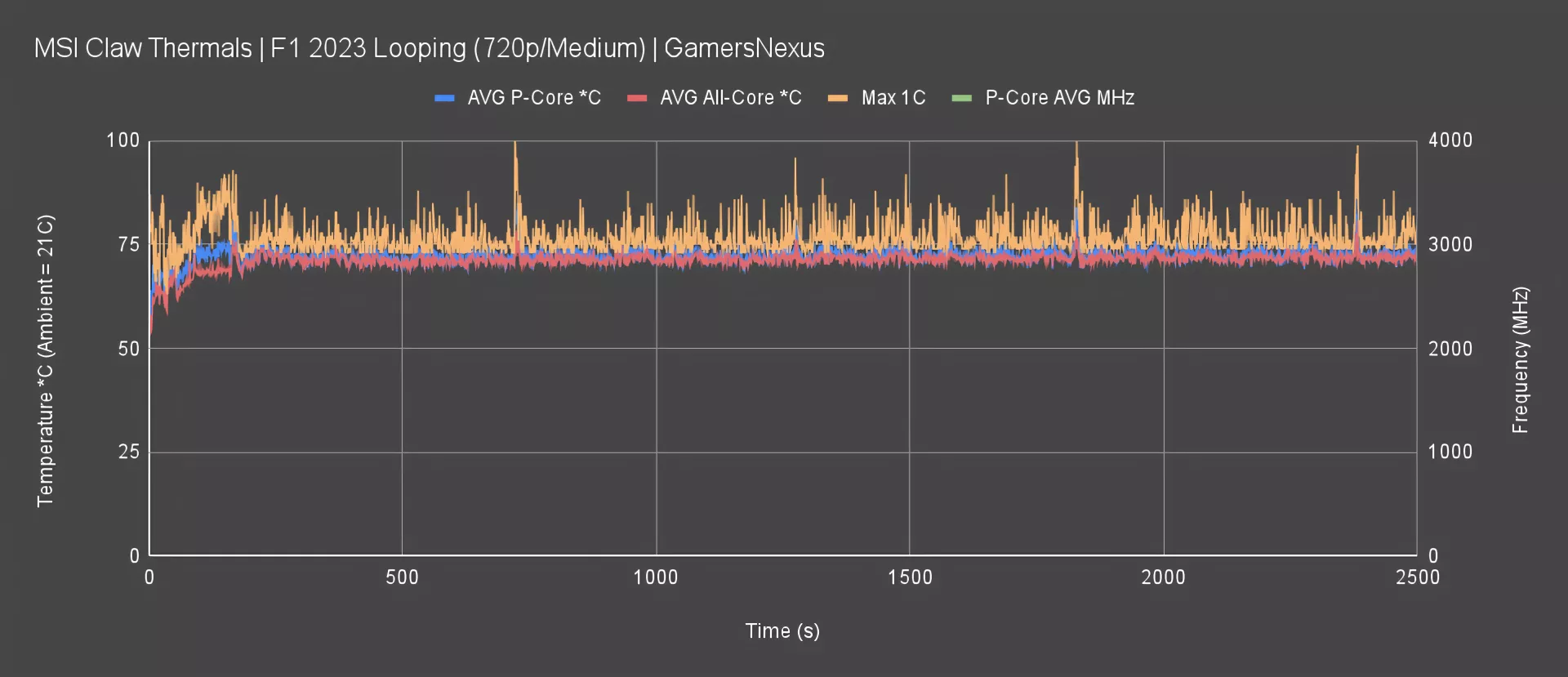
Here’s the thermal situation: In a full torture workload, where we have the device charging while gaming in its maximum power profile, the Claw produces these numbers. Because it’s charging, the charger IC is heating up the system alongside the battery and SOC. That’s a lot of heat in the box. Anywhere we’re CPU-bound, such as the initial loading of the assets in the first few minutes, the temperature climbs to 101 degrees on the hottest core of any given row of data. That could indicate bad contact distribution of the cooler, but could equally be indicative of hotspots within the CPU, such as on a priority core. With a GPU load, which is when we’re running laps in F1 in this test, the temperatures stay generally around 75 degrees for the cores and 86 for the hottest core. Any shift to CPU-only load, like the loading screen that happens around 700 seconds, 1300 seconds, 1700 seconds, and 2400 seconds spikes us to 101 degrees.
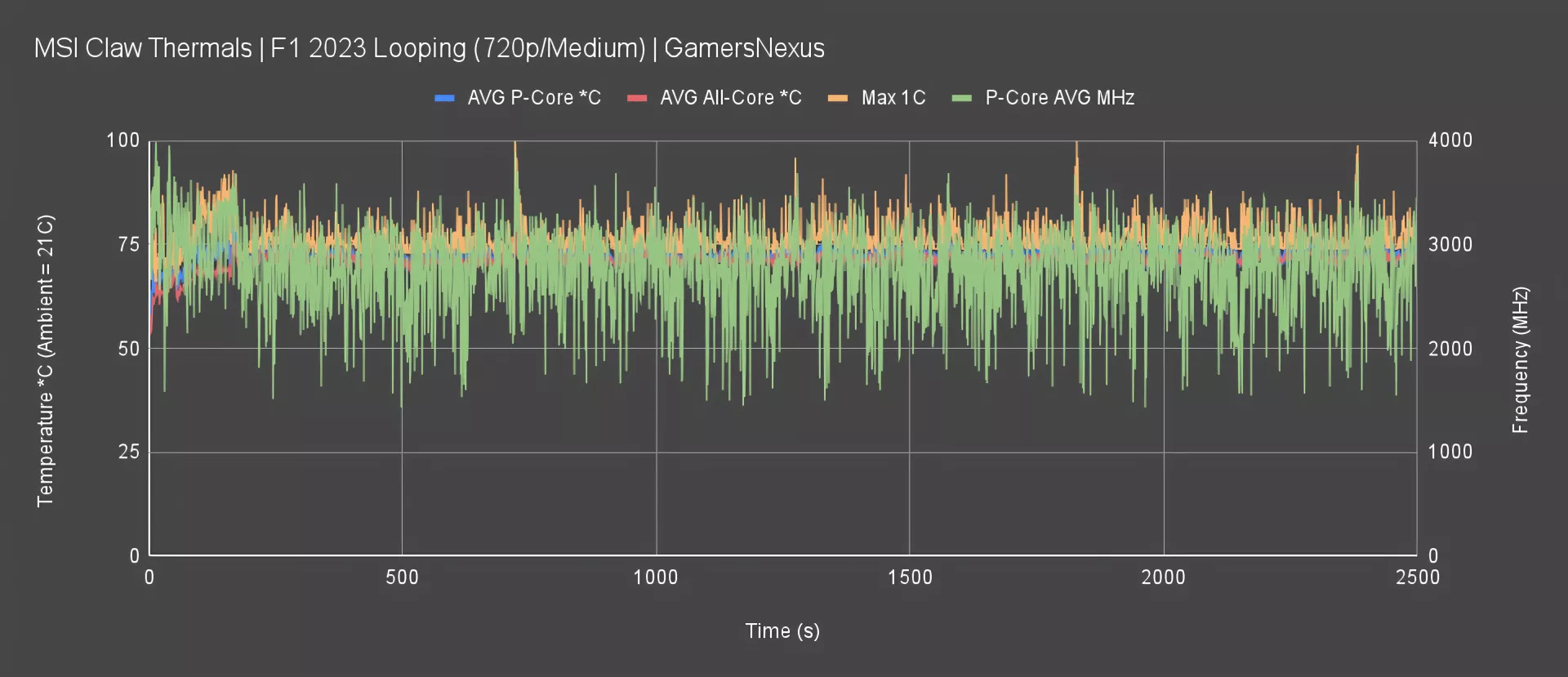
We’ll overlay a layer for the frequency: These spikes always happen just after the CPU frequency spikes to around 3900MHz. As with Intel’s desktop CPUs, insufficient cooling means the solution can’t tame the huge push for frequency.
The good news is that it wasn’t throttling during the GPU load this game produced. The bad news is that it’s not as controlled as it should be.
MSI Claw Conclusion

Our conclusion is interesting for this one: In addition to the usual objective analysis and subjective in-office opinions, we had the opportunity to take this one on flights and test it, maybe in one of its best use cases.
We’ll approach that side first, so these are our opinions on it as a handheld in general:
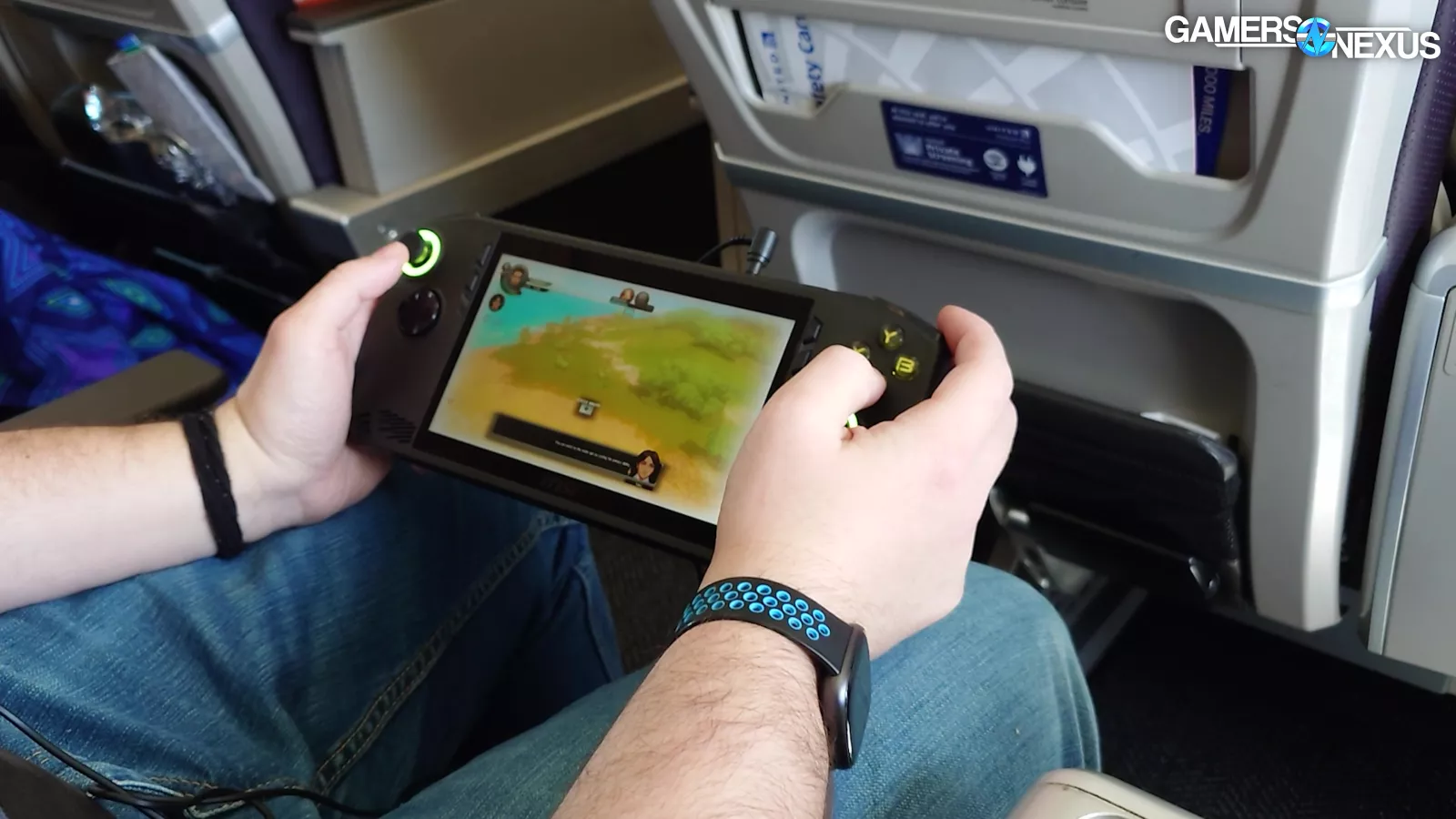
In the cramped and torturous environment of a 14-hour flight that’s 10 hours into a 24-hour journey, you stop caring about a lot of the specifics of framerate. What mattered were only two things: That it was playable, and that meant 20 FPS in non-precision games was fine as long as it was consistent and non-stuttery, and that it had good battery life. If the device died in an hour, it wouldn’t be worth the carry-on luggage space.
Without using it in a controlled testing way, we switched between brightness and power profiles purely based on how we felt as end users, not how we felt as testers. We ended up with about an hour and 45 minutes of play time in Brew Barons, which is an awesome game.
Purely subjectively, we couldn’t have cared less about an extra 5 FPS: It achieved the goal, which was run well enough to serve as a distraction.
What we would have cared about boils down to value and battery. On the value side, it’s much worse value than competing devices -- especially at the nearly $800 we paid. The battery life also isn’t the best.
You could use the in-seat charger if it’s working and your neighbor doesn’t want it, but battery still matters most.
The overlay was at times annoying and we did have occasional crashes as a result of Arc drivers mixed with the Super Battery power state. If we were to take one not for a review, we’d bring either the Deck or Ally instead.
Now to the objective side: In the game tests we ran, the Claw could perform up to the level of an Ally Z1X, but with an identical screen spec, the same memory capacity, more storage, and potentially more battery life. That makes the Claw sound better, but it isn't. The Claw's one-word summary is "inconsistent," and it costs more.
It also doesn't bode well for the Claw that its bottom tier power profile isn't strongly differentiated from its highest tier in comparison to the other devices. If you're trying to maximize battery life, that's as low as the slider will go.
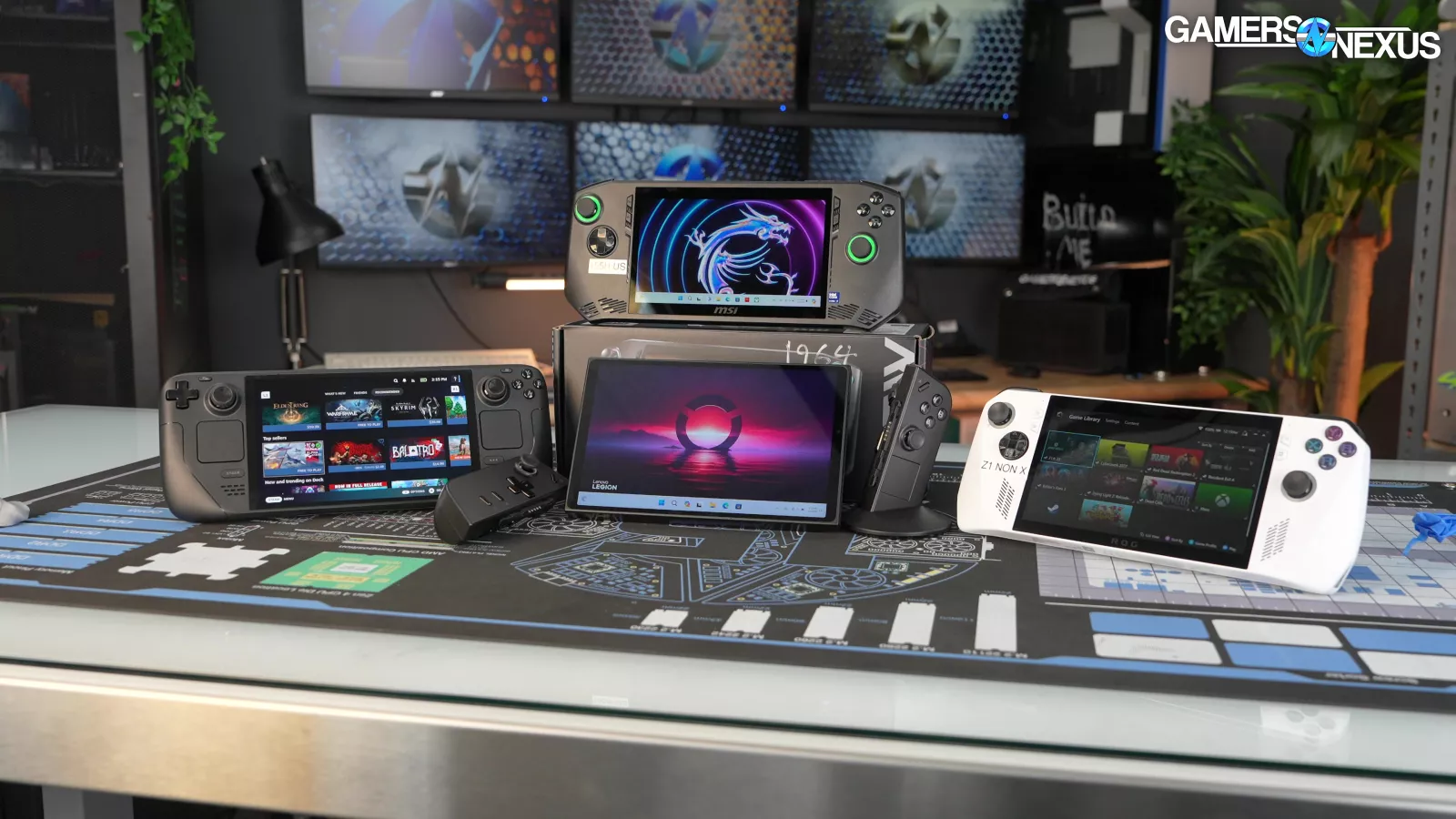
The existence of the Claw is a mystery. We suspect there may be Intel marketing development funding involved. Even the Legion Go is cheaper, and the Go has a higher resolution, higher refresh rate, faster memory, support for 2242 SSDs, and detachable controllers. We're happy to see some silicon variety, but it’s clear why manufacturers have stuck with the safe Z1 Extreme/7840U/8840U choice.
As for handhelds we can recommend, the Ally Z1X has the highest performance-per-dollar with some reliability issues, the Deck OLED has a good balance of battery life, screen quality, and price combined with stable frametimes, and the Ally Z1 has become a competitive budget choice with huge discounts as low as $300-$400. If the top-tier Claw drops to price parity with the top-tier Ally Z1X, we'll reevaluate.
The conclusion, simply put, is this: There’s no reason to settle for “good enough” when “better” is cheaper.

